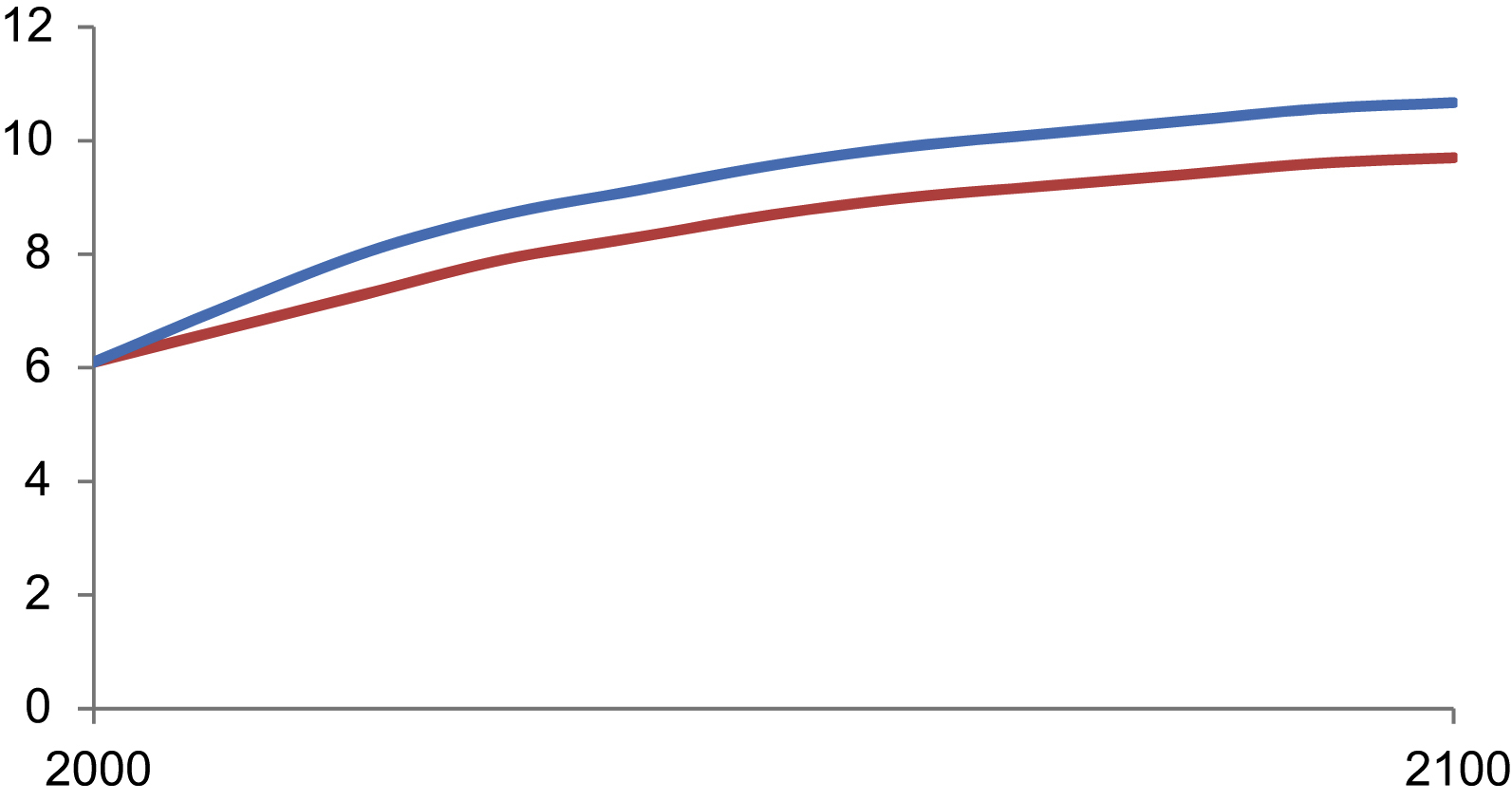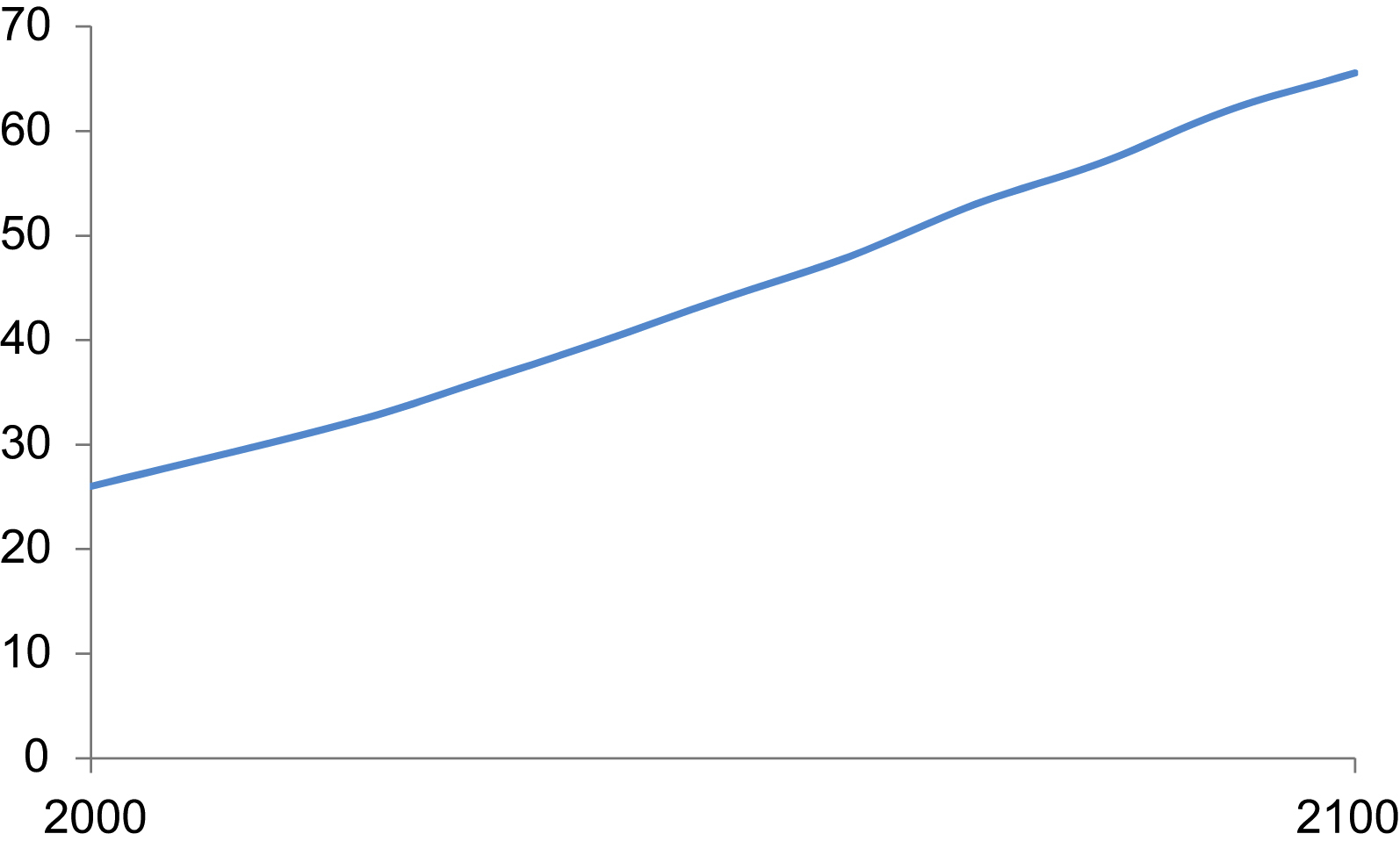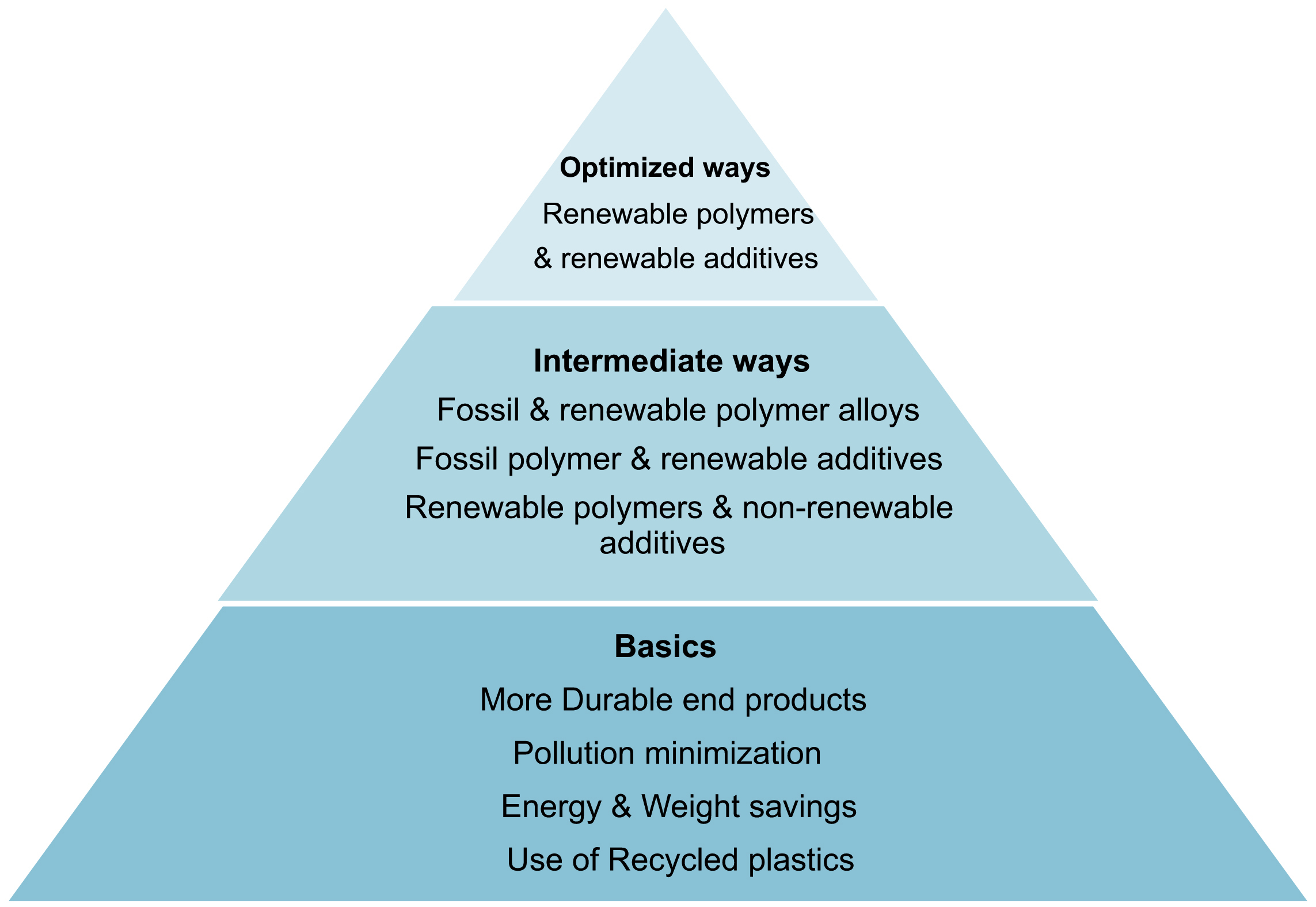Genesis of Renewable Plastics and Integration in the Plastics Stream
Abstract
Predictions (up to 2100) of global population growth and gross domestic product per capita should lead to higher industrial activity, depletion of resources, consumption of energy, and pollution. Our earth being an isolated system, except for sun energy, it is essential to preserve the indispensable needs of future generations during a maximum time. That has led to genesis and growth of renewable plastics. Pros and cons of oil-sourced plastics and renewable ones coming from recycling, natural polymers, and natural monomers or oligomers are reviewed. Special tests and certification are examined. An extended list of commercial players allows to feel the reality of the commercial offer related to renewable plastics (polylactic acid, starch, cellulose, lignin, polyurethane, polyamide, polyethylenes, polyesters, epoxy,…), composites, recyclers and recycling enhancers, special additives, biomonomers, and biobricks for drop-in solutions, renewable additives (plasticizers, processing aids, and others). A list of market study specialists, associations, and institutes dealing with renewable materials supplements the list of the Chapter 1 relating to general plastics.
Keywords
2.1. Inescapable Strengthening of Environmental Concerns
2.1.1. Toxicity and Pollution
2.1.2. The Recycling of Polymers
2.2. Development of Bioplastics From Renewable Sources
2.2.1. Development of Biothermoplastics From Renewable Sources
2.2.2. Development of Biothermosets From Renewable Sources
2.3. Pros and Cons of Renewable and Oil-Sourced Plastics
2.3.1. Renewable Plastics Derived From Natural Polymers
2.3.2. Traditional Plastics From Bioblocks: Drop-In Solutions
2.3.3. Traditional Plastics From Plastics Waste Recycling
2.4. Brief Remarks on Processing and Recycling of Renewable Plastics
2.5. Pay Close Attention to Carbon Biobased Content, Testing and Certification
Table 2.1
Examples of Equipment Builders for WPC (Wood Plastic Composite)
| Company | |
| Advanced Extruder Technologies | Design, engineering, and manufacturing of single screw extruders |
| American Cierra Equipment | New and used equipment for the plastics industry |
| American Maplan Corporation | Parallel counterrotating twin-screw extruders, single-screw extruders, two stage planetary extruders, and other equipment for natural fiber composites |
| Amut Group | WPC extrusion lines |
| Automated Manufacturing Systems (AMS) | New and used plastic extrusion equipment |
| Battenfeld-Cincinnati | Fiberex 114 parallel twin-screw extruder for WPC |
| BAUSANO-FIGLI-SPA | WPC-Polywood lines |
| Berlyn Extruders, Inc | Wide range of extrusion machinery including complete systems, stand-alone extruders, feeders, filters, pelletizing, and reclaim equipment |
| Capital Equipment, LLC | New and used equipment. Dryers, chillers, extruders |
| CDL Technology, Inc. | Designing; manufacturing; and servicing plastic, chemical, and rubber processing equipment |
| CDS (Custom Downstream Systems) | Standard and custom downstream machinery for thermoplastic extrusions and postextruder machines |
| Coperion Corporation | ZSK MEGA twin-screw extruder for processing of wood fiber composites |
| Davis-Standard | Designs and manufactures extrusion systems and process controls for all thermoplastic and elastomer processes |
| ESI—Extrusion Services | Downstream extrusion equipment and tooling; complete engineered line system services for the wood composite industry |
| Industrial Rubber Machinery, Inc | Composite material manufacturing systems and equipment. Plastic wood, composite wood, recycled material recovery systems, plastic extruders |
| Kraussmaffei Berstorff | System solutions for natural fiber-reinforced plastics |
| Leistritz Extruder Corp | High-speed corotating and counterrotating twin-screw extruders |
| Milacron, Inc. | Conical and parallel twin-screw technology and single-screw technology for extrusion from wood fiber–plastic composites |
| Qingdao-Weier-Plastic-Machinery-Co | WPC machines |
Reifenhäuser Extrusion GmbH and Co. KG | Extrusion lines, compounding lines, single and twin-screw extruders for wood polymer composites (WPC) and biopolymers |
| Vulcan Machinery Corporation | Downstream plastic extrusion equipment |
| Weber | WPC extrusion lines |
| Welex Incorporated | Manufacturer of performance plastics extrusion equipment |
2.6. List of Commercial Offer Examples
2.7. Examples of Useful Sources for Initiation of In-Depth Studies
Table 2.2
Examples of Plastics Grade Certification by Vinçotte (OK Biobased Conformity Mark)
| Company | Country | Website | Certification (Star Number), Grade, Color |
| BEOLOGIC nv | BELGIUM | http://www.beologic.com | ∗∗ 50/50 PP inj biobased WQ3 Color: Natural beige |
| BIOTEC GmbH & Co. KG | GERMANY | http://www.biotec.de | ∗∗∗ BIOPLAST 105 Color: White translucent ∗∗ BIOPLAST 505 Color: White translucent ∗ BIOPLAST GF 106/02 Color: White translucent ∗∗∗ BIOPLAST GS 2189 Color: White translucent ∗∗∗∗ BIOPLAST TPS Color: White translucent |
| COMTECH CHEMICAL Co Ltd | KOREA | http://www.ctc-bionics.com | ∗ Duflex E Project E35 Color: Grey |
| FUTURAMAT | FRANCE | http://www.futuramat.fr | ∗∗∗∗ BioCérès type BC-LBE03 Color: Beige |
| GREAT RIVER PLASTIC MANUFACTURER | CHINA | http://www.ecoplant.hk | ∗∗∗∗ EcoPlant HRS Color: Natural white |
| Guangdong Shangjiu Biodegradable Plastics Co | CHINA | http://www.999sw.net | ∗∗ BOR-M-502F Color: light yellow ∗∗ BOR-Z-501F Color: light yellow |
| HWAN SUH BIOTECHNOLOGY Co Ltd | Taiwan, R.O.C. | http://www.greenfiber.net.tw | ∗∗∗∗ EcoFiber PLF 0411 Color: Brown ∗∗∗∗ EcoFiber PLF 2011 Color: Brown ∗∗∗∗ EcoFiber PLF 5030 Color: Beige |
| INDOCHINE BIO PLASTIQUES (ICBP) SDN.BHD. | MALAYSIA | http://www.icbp.com.m | ∗∗ ICBP BIO RESIN Color: Natural (beige) |
| JINHUI ZHAOLONG HIGH TECHNOLOGY Co Ltd | CHINA | http://www.ecoworld.jinhuigroup.com | ∗ Ecowill PBAT/starch Color: Beige |
| KANEKA Corporation | JAPAN | http://www.kaneka.co.jp/kaneka-e/ | ∗∗∗∗ AONILEX 151C Color: Ivory ∗∗∗∗ AONILEX X131A Color: Ivory ∗∗∗∗ AONILEX X151A Color: Ivory |
| KINGFA SCI. & TECH. CO., LTD | CHINA | http://www.kingfa.com.cn | ∗∗∗∗ Ecopond BIO-873 Color: Beige ∗∗ Vicnyl 6∗∗ Color: Natural white ∗∗ Vicnyl 7∗∗ Color: Natural beige ∗∗ Vicnyl L6∗∗ Color: Natural white ∗∗ Vicnyl L7∗∗ Color: White ∗∗ Vicnyl R6∗∗NH Color: Natural White |
| Table Continued | |||
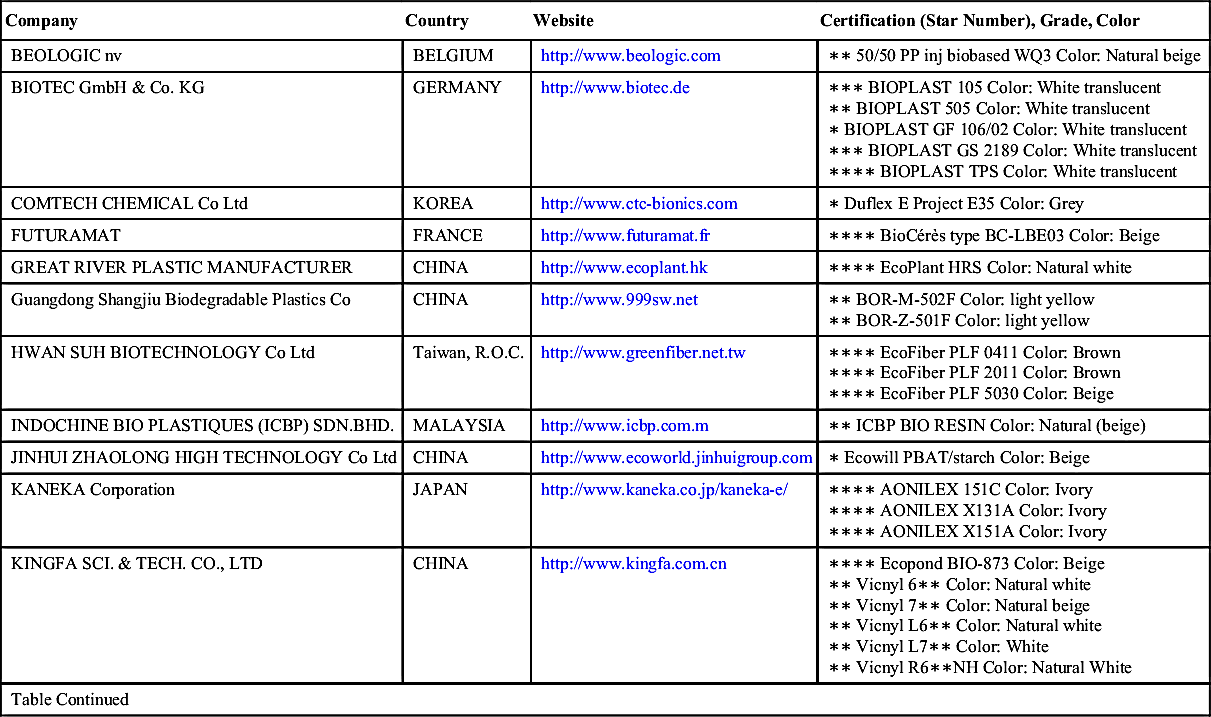
| Company | Country | Website | Certification (Star Number), Grade, Color |
| LATI Industria Termoplastici S.p.A. | ITALY | http://www.lati.com | ∗∗∗∗ LATIGEA B01 L/07 GREY:2865 Color: Natural White (light grey) |
| MEREDIAN Inc | USA | http://www.mhgbio.com | ∗∗∗∗ Meredian Color: Natural yellow/beige ∗∗∗∗ Meridian Color: Natural yellow/beige |
| MONDOPLASTICO Spa | ITALY | http://www.mondoplastico.it/ | ∗∗ ES#A56NWR Color: White ∗∗ ES#A56NWRDG Color: White |
| MULTIBAX Public Company Ltd | THAILAND | http://www.multibax.com | ∗ MBIO-4 Color: Greyish, natural white |
| NATUREWORKS LLC | USA | http://www.natureworksllc.com | ∗∗∗∗ Ingeo 10361D Color: Natural ∗∗∗∗ Ingeo 2003D–2500HP–3001D Color: Natural ∗∗∗∗ Ingeo 3052D–3100HP–3251D–3260HP Color: Natural ∗∗∗∗ Ingeo 4032D–4043D–4060D Color: Natural ∗∗∗∗ Ingeo 5061A–5061B Color: Natural ∗∗∗∗ Ingeo 6060D–6100D–6201D–6202D–6204D Color: Natural ∗∗∗∗ Ingeo 6252D–6260D–6300D–6302D–6361D Color: Natural ∗∗∗∗ Ingeo 6400D–6752D Color: Natural ∗∗∗∗ Ingeo 7001D–7032D–8052D–8251D Color: Natural ∗∗∗∗ Ingeo 8300D - 8301D - 8302D Color: Natural |
| NINGXIA QINGLINSHENGHUA Technology Co Ltd | CHINA | http://www.nxlhsw.com | ∗ JIAJIAGU QLP-G1 Colour: White ∗∗ JIAJIAGU QLP-G2 Color: White ∗∗∗∗ JIAJIAGU Totalcorn GS Color: White |
| NORTHERN Technologies Intl. Corp. | USA | http://www.naturbag.com | ∗∗∗∗ Natur-Tec BF 3002 Color: Natural White |
| PERSTORP AB | SWEDEN | http://www.perstorp.com | ∗∗∗ CAPA 85014A Color: Transparent |
| PLANTIC Technologies Ltd | AUSTRALIA | http://www.plantic.com.au/ | ∗∗∗∗ Plantic HP1 Color: Natural ∗∗∗∗ Plantic R1 Color: Natural |
| POU CHEN Corporation | Taiwan, R.O.C. | http://www.pouchen.com | ∗ ECOLON Color: White ∗ eFFA-skin Color: White ∗ Rubby Color: Neutral |
| Table Continued | |||
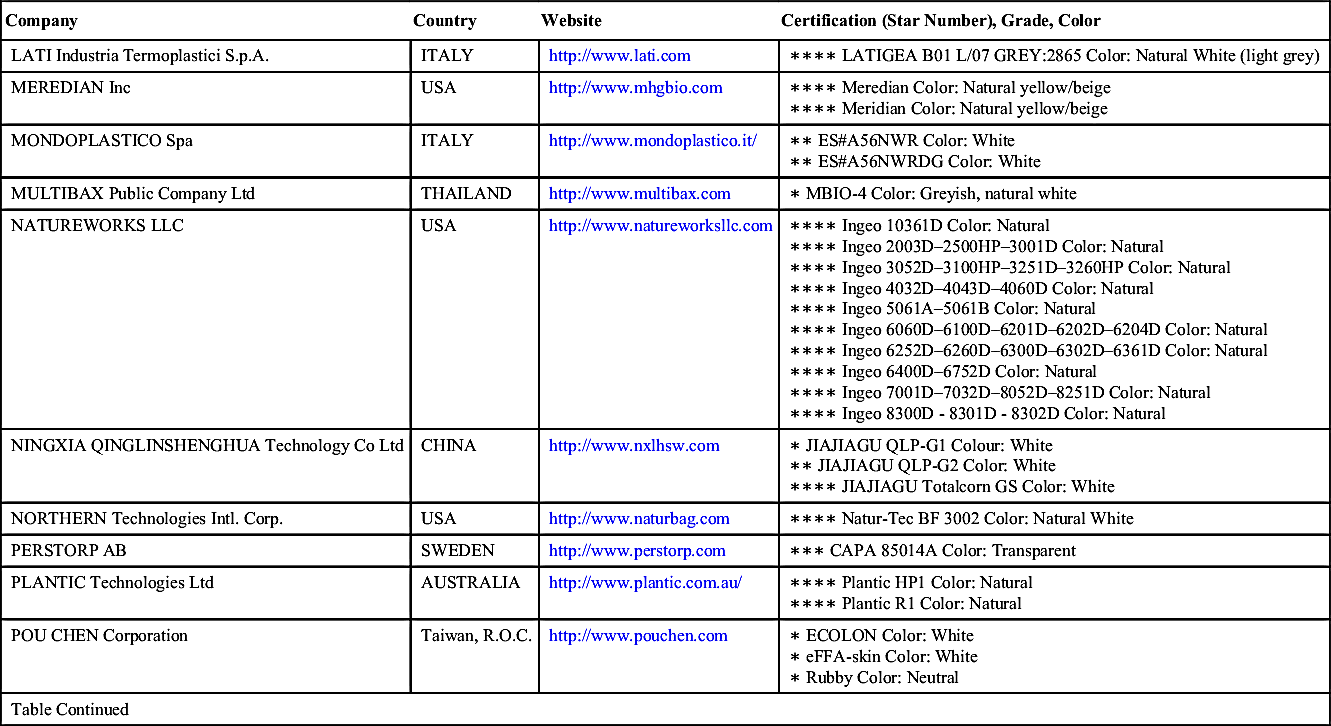
| Company | Country | Website | Certification (Star Number), Grade, Color |
| RESIRENE SA de CV | MEXICO | http://www.resirene.com | ∗ BIORENE HA-40 |
| RODENBURG BIOPOLYMERS | THE NETHERLANDS | http://www.biopolymers.nl | ∗∗∗ FlourPlast SG1 G Color: Yellowish ∗∗∗ FlourPlast SG2 G Color: Yellowish ∗∗∗ SOLANYL C1201 Color: Natural white translucent ∗∗∗ SOLANYL C1401 Color: Natural white translucent ∗∗∗ SOLANYL C2201 Color: Natural white translucent ∗∗ SOLANYL C8101 Color: Natural White |
| SHENZHEN HONGCAI NEW MATERIAL Tech. Co | CHINA | http://www.biohongcai.com | ∗∗ DF-101 Color: Beige ∗∗∗ DI-102 Color: Beige |
| SOFTER TECNOPOLIMERI Srl | ITALY | http://www.softerspa.com | ∗∗∗∗ Plantura 67C1 WR NAT001 Color: Natural ∗∗∗∗ Plantura 80VT4 NAT001 Color: Natural |
| SOLVAY ACETOW GmbH | GERMANY | http://www.solvay.com | ∗∗ OCALIO Color: Transparent |
| SUZHOU HANFENG NEW MATERIAL Co Ltd | CHINA | http://www.biohanfeng.com | ∗∗ BIZ-008 Color: Light yellow |
| TIANJIN GREENBIO MATERIAL Co Ltd | CHINA | http://www.tjgreenbio.com | ∗∗∗∗ SoGreen P(3,4HB) resin 1001 Color: Light ivory ∗∗∗∗ SoGreen P(3,4HB) Resin 2001 Color: Light ivory ∗∗∗∗ SoGreen P(3,4HB) resin 3001 Color: Light ivory |
| TORAY Industries, Inc | JAPAN | http://www.toray.co.jp | ∗ Ecodear V751 X53 Color: Natural White |
| WUHAN HUALI | CHINA | http://www.psm.com.cn | ∗∗∗ 100B Color: Natural White ∗∗ 100C Color: Natural White ∗ HL-101-40 Color: Natural White ∗∗ PSM HL-101 Color: White ∗∗ PSM HL-102 Color: White ∗∗ PSM HL-103 Color: Natural ∗ PSM HL-203C Color: Ivory ∗∗∗∗ PSM HL-300A Color: White |
| ZHONGSHAN GUANGMAO Bio-Plastics Technol | CHINA | ∗∗ GM-BF-20501 Color: light yellow ∗∗ GM-CF-30502 Color: light yellow |
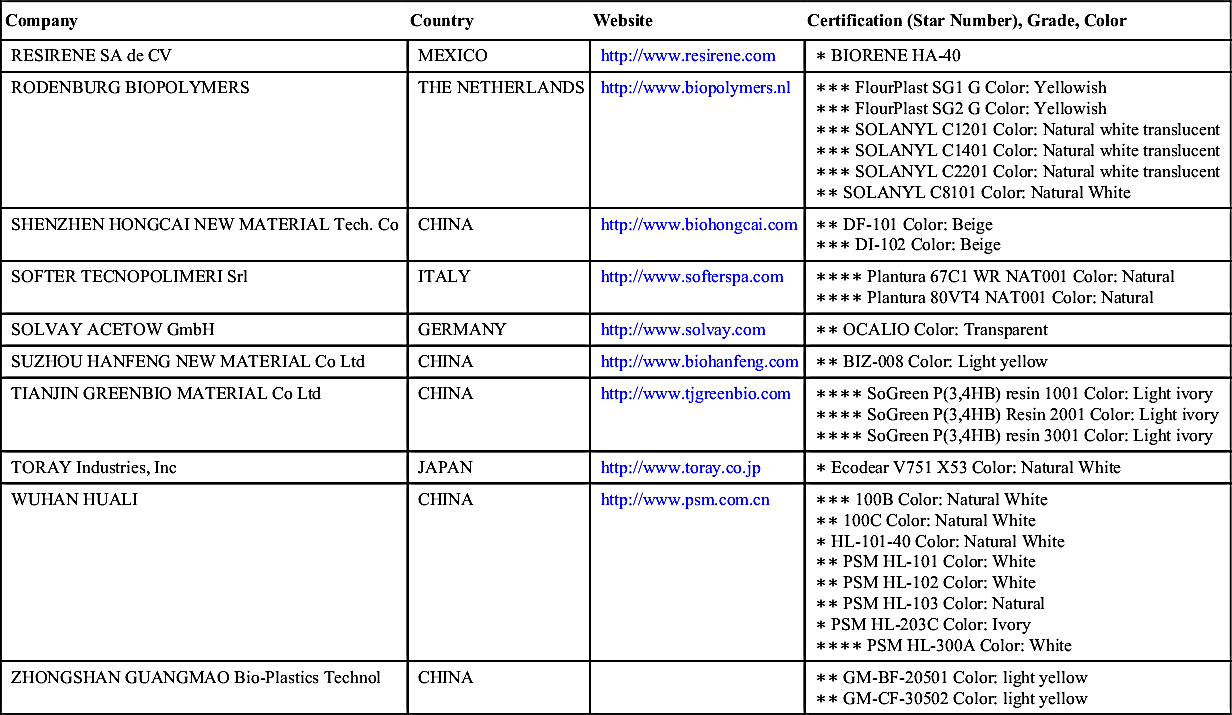
Table 2.3
Examples of Producers of Renewable Plastics
| Polymer | Company | Website | Brand Name |
| Polylactic acid (PLA) derivatives | |||
| PLA | Corbion Purac | http://www.corbion.com/ | Purac |
| PLA | Futerro | http://www.futerro.com/index.html | Futerro |
| PLA | NatureWorks | http://www.natureworksllc.com/ | Ingeo |
| PLA | Showa Denko | http://www.showa-denko.com/ | Bionolle Starcla |
| PLA | Synbra | http://www.biofoam.nl/index.php | Biofoam |
| PLA | Zhejiang Hisun Biomaterials | http://en.hisunplas.com/ | Hisun |
| PLA | Teijin | www.teijin.co.jp/english/ | BIOFRONT™ |
| PLA blend | FKuR Kunststoff | www.fkur.com/ | Bio-Flex® |
| PLA/starch | Biotec | http://www.biotec.de/prod/ | Bioplast |
| Starch derivatives | |||
| Starch-based | BecauseWeCare | www.becausewecare.com.au/ | BF90 |
| Starch-based | BiologiQ | www.biologiq.com/ | EcoStarch |
| Starch-based | Biop Biopolymer Technologies AG | www.bio-plastics.org/en/ | BIOPAR® |
| Starch-based | Biotec | http://www.biotec.de/prod/ | Bioplast |
| Starch-based | Cardia bioplastics | http://www.cardiabioplastics.com/index.php?nodeId=14 | Cardia Biohybrid™ Cardia Compostable |
| Starch-based | Green Dot | www.greendotpure.com/ | Terratek® Flex |
| Starch-based | Japan Corn Starch | http://www.nihon-cornstarch.com/product/bio_plastic/tabid/160/Default.aspx | Cornpole |
| Limagrain | http://www.biolice.com/english/index_e.html | Biolice | |
| Starch-based | Novamont | http://www.novamont.com/ | Mater-Bi® |
| Starch-based | Plantic | http://www.plantic.com.au/ | Plantic, Plantic eco Plastic™ |
| Starch-based | Rodenburg Biopolymers | http://www.biopolymers.nl/company | Solanyl |
| Starch-based | Roquette | http://www.gaialene.com/ | GAÏALENE® |
| Starch-based | Solanyl Biopolymers Inc | http://solanylbiopolymers.com/ | Solanyl FlourPlast |
| Starch-based | Stanelco | www.biometechnologiesplc.com/ | Bioplast® |
| Starch-based | Vegeplast | VEGEMAT® | |
| Table Continued | |||
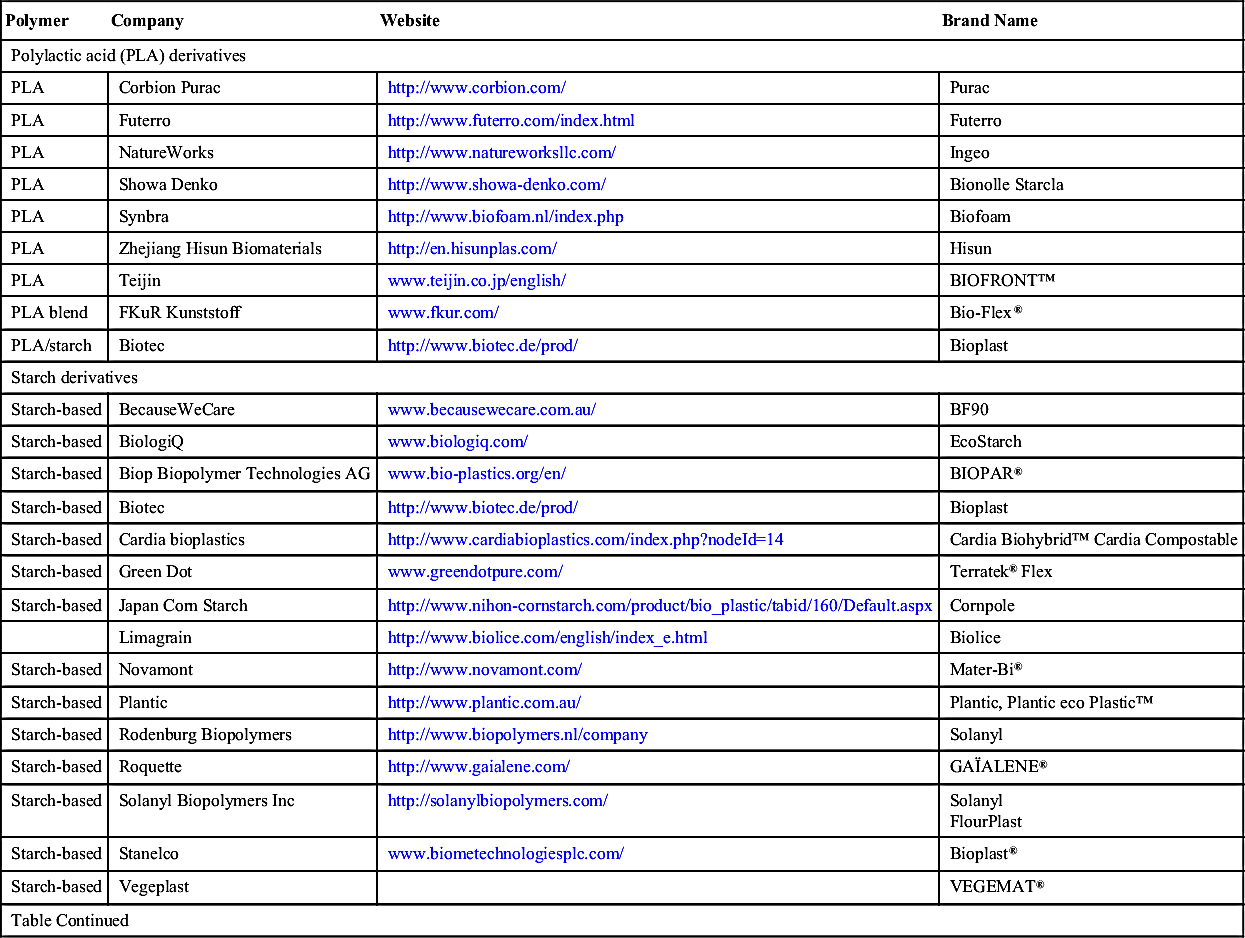
| Polymer | Company | Website | Brand Name |
| Starch, cellulose, straw | Wuhan Huali Environment Protection—PSM | http://www.psm.com.cn/eng/index.asp | PSM |
| Cellulose derivatives | |||
| Cellulose ester | Celanese Acetate Products | http://www.celaneseacetate.com/ | |
| Cellulose ester | Daicel | http://www.daicel.com/ | |
| Cellulose ester | Eastman | http://www.eastman.com/ | |
| Cellulose ester | Innovia films | http://www.innoviafilms.com/ | |
| Cellulose ester | Mazzucchelli1849 | http://www.mazzucchelli1849.it/ | |
| Cellulose ester | Planet Plastics Cy | http://www.planetplastics.com/ | |
| Cellulose ester | Rhodia | http://www.rhodia.com/ | |
| Cellulose ester | Rotuba | http://www.naturacellnow.com/ | |
| Cellulose ester | Sateri | http://www.sateri.com/ | |
| Lignin derivatives | |||
| Lignin-based | Cyclewood Solutions | http://cyclewood.com/ | Xylomer™ |
| Lignin-based | Tecnaro | http://www.tecnaro.de/english/ | Arboform |
| Renewable, green, bio, or eco—PUR (polyurethane), TPU (thermoplastic polyurethanes) | |||
| PUR | Alberdingk® | http://www.alberdingk-boley.de/en.html# | |
| PUR | BASF | https://www.basf.com/en | CosyPUR™ BALANCE |
| PUR | BASF | https://www.basf.com/en | Lupranol® BALANCE |
| PUR | Biobased Technologies | http://www.biobased.net/company.php | |
| PUR | Croda | www.croda.com/ | |
| PUR | Johnson Controls Inc. | http://www.johnsoncontrols.com/content/us/en/ | |
| TPU | Merquinsa® | www.merquinsa.com/ | Pearlthane® ECO |
| PUR | Rampf Ecosystems | http://www.rampf-gruppe.de/en/companies-and-products/eco-solutions/base-polyols/ | |
| PUR | Rhino Linings | http://biobased.rhinolinings.com/products/index.html | |
| PUR | Succinity JV BASF/Purac | http://www.succinity.com/ | |
| PUR | The Dow Chemical Company | www.dow.com/ | |
| Table Continued | |||
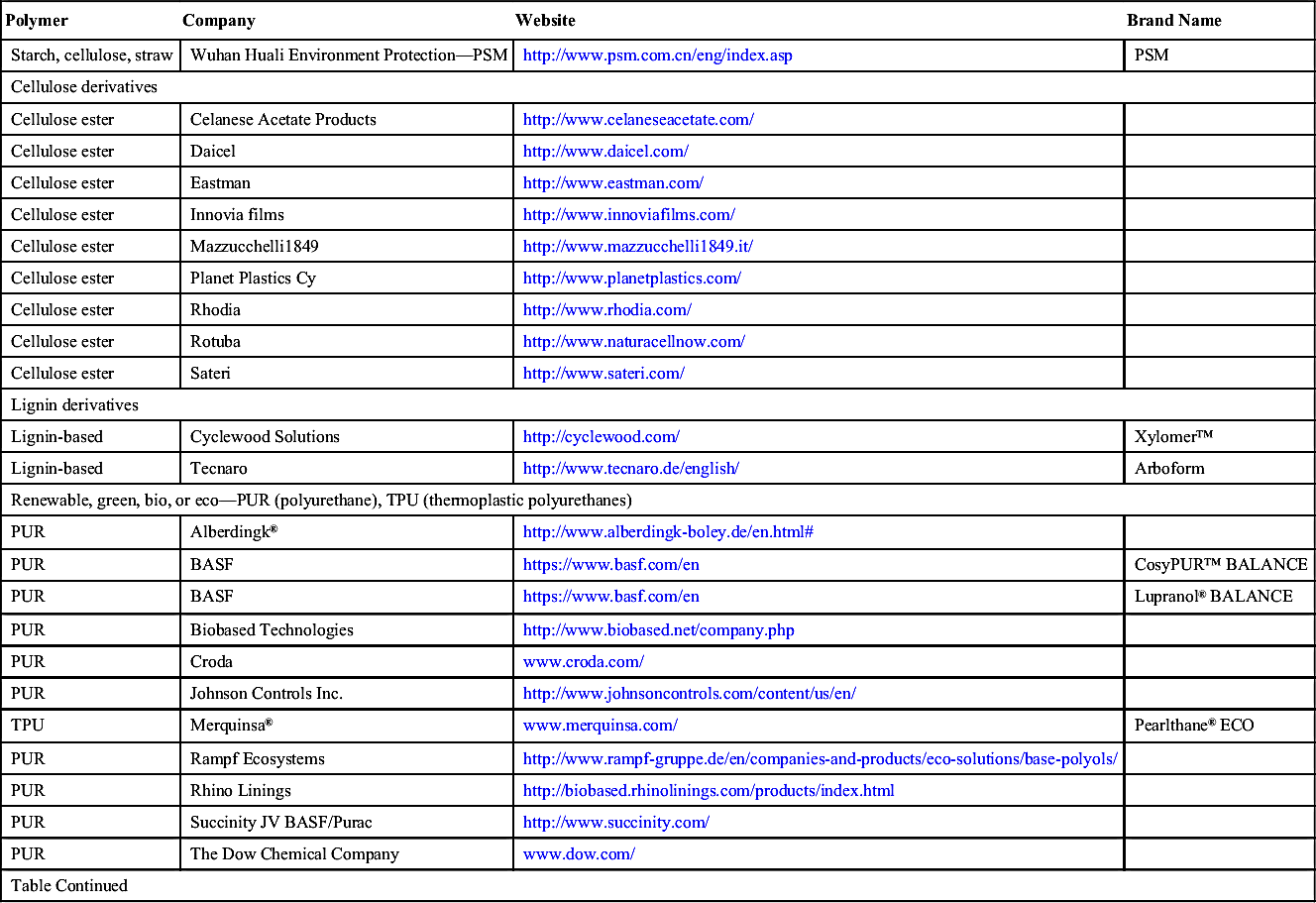
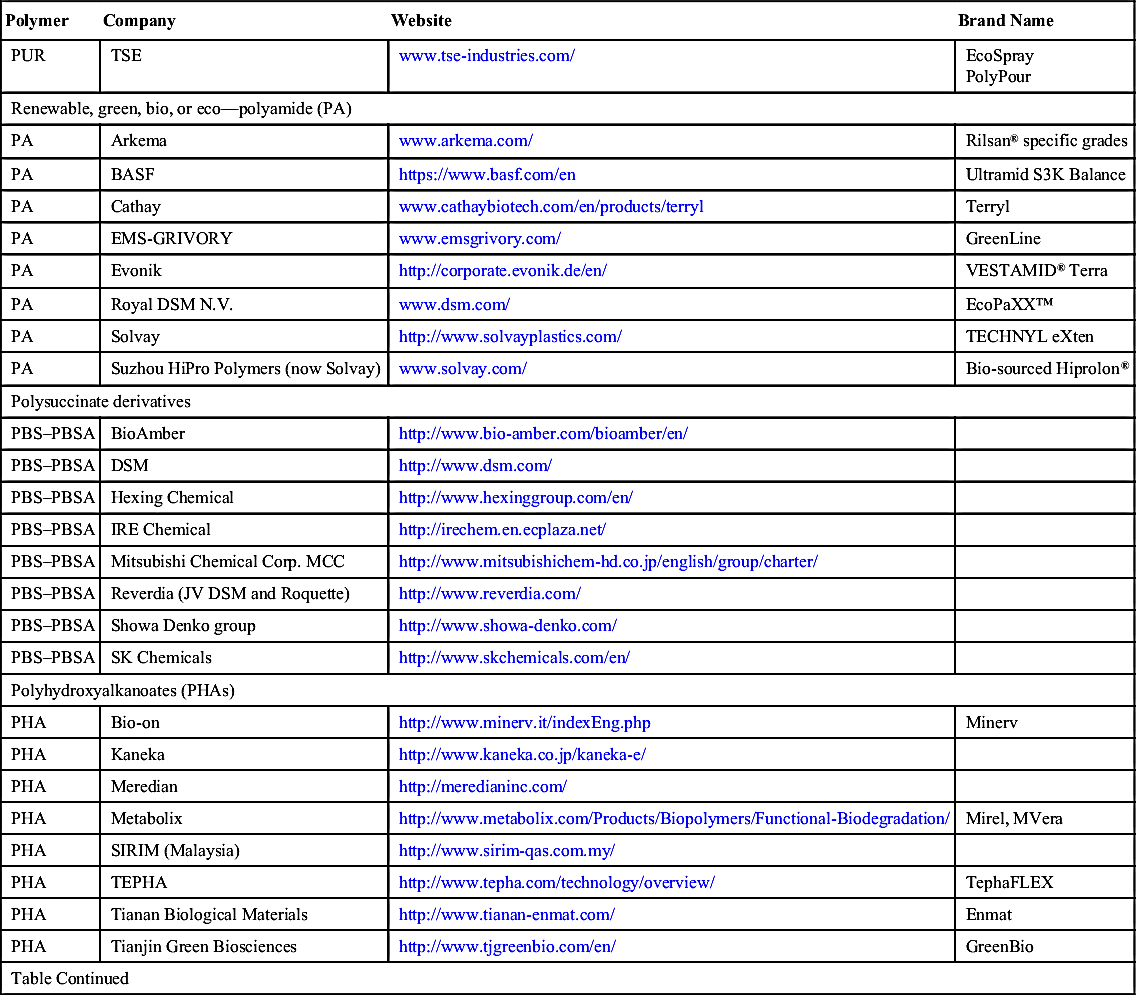
| Polymer | Company | Website | Brand Name |
| PHB | Biomer | www.biometechnologiesplc.com/ | P209 PHB |
| PHB | PHB Industrial | http://www.biocycle.com.br/imprensa_ing_01.htm | Biocycle |
| PHBH | Kaneka | www.kaneka.com/ | AONILEX® |
| P4HB | Tepha | www.tepha.com/ | TephaFLEX® |
| Miscellaneous polyesters | |||
| Fossil BAT | BASF | https://www.basf.com/en | Ecoflex |
| PBAT + PLA | BASF | https://www.basf.com/en | Ecovio |
| Polyester | SK Chemicals | www.skchemicals.com/ | SKYTHANE® |
| Renewable polyethylene (PE) | |||
| PE | Braskem | www.braskem.com/ | GreenPE |
| PE | Sabic | www.sabic.com/ | RENEWABLE POLYOLEFINS |
| Thermoplastic polyester resins or components | |||
| Polyester | Gevo Inc. | www.gevo.com/ | |
| Polyester | Indorama Ventures | http://www.indoramaventures.com/EN/ | RAMAPET |
| Polyester | Toyota Tsusho Corp., | www.toyota-tsusho.com/english/ | GLOBIO Bio-PET |
| Polyester | Virent Energy Systems Inc. | www.virent.com/ | |
| PEF | Avantium | www.avantium.com/ | |
| PBT | Toray | http://www.toray.co.jp | |
| PBT | Lanxess | www.lanxess.com/ | |
| PBT | Genomatica | www.genomatica.com/ | |
| TPEE | DuPont Engineering Polymers | http://www.dupont.com/ | Hytrel® RS |
| TPEE | DSM | www.dsm.com/ | Arnitel ECO |
| Unsaturated polyesters (UP) | |||
| UP | AOC | www.aoc-resins.com/ | EcoTek |
| UP | Ashland | www.ashland.com/ | Envirez |
| UP | DSM | www.dsm.com/ | Palapreg® ECO |
| UP | Polynt Composites | http://www.ccpcomposites.com | Enviroguard |
| UP | Reichhold | www.reichhold.com/ | Envirolite |
| Other thermoplastics | |||
| PC | Mitsubishi Chemical | Durabio | |
| PC | Teijin | www.teijin.co.jp/english/ | Planext |
| PP | Braskem | www.braskem.com/ | |
| PVC | Solvay | http://www.solvayplastics.com/ | |
| Table Continued | |||
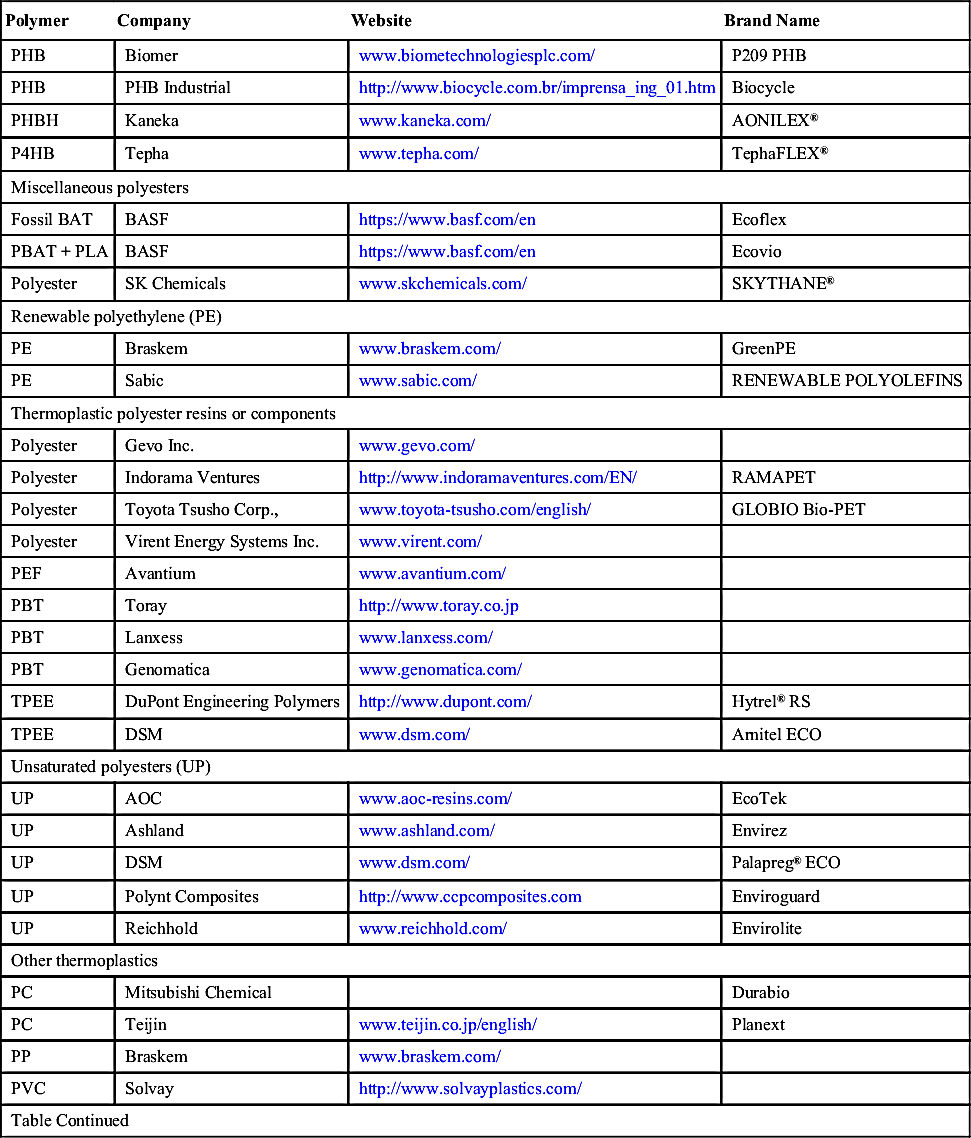
| Polymer | Company | Website | Brand Name |
| PMMA | Altuglas | www.altuglas.com/ | Altuglas® Rnew |
| Other thermosets | |||
| Epoxy resin and component producers using renewable resources | |||
| EP | Cardolite | http://www.cardolite.com/ | |
| EP | CVC Thermoset Specialties | http://www.cvc.emeraldmaterials.com/ | ERISYS™ |
| EP | Dragonkraft | http://www.dragonkraft.com/ | |
| EP | Ecopoxy | http://ecopoxy.com/ | |
| EP | Entropy Resins | http://www.entropyresins.com/ | |
| EP | Huntsman | http://www.huntsman.com/corporate/a/Home | |
| EP | Solvay | http://www.solvayplastics.com/ | |
| EP | Spolchemie | http://www.spolchemie.cz/en/ | CHS-EPOXY® |
| EP | Systemthree | http://www.systemthree.com/ | |
| Phenolics | |||
| PF | Cardolite | http://www.cardolite.com/ | |
| Furanics | |||
| Furanic | TransFurans Chemicals (TMC) | www.transfurans.be/ | |
| Proprietary and nonclassified compounds | |||
| Proprietary | API | http://www.apinatbio.com/eng/apinat-bioplastics.html | APINAT bio |
| Proprietary | API | http://www.apiplastic.com/ | APIGO bio |
| Proprietary | BASF | https://www.basf.com/en | ECOBRAS |
| Proprietary | Biofase | http://www.biofase.com.mx | |
| Proprietary | BIOP by Biopolymer Technologies | www.bio-plastics.org/en/ | BIOPAR® |
| Proprietary | Ceres | www.cerestech.ca/ | |
| Proprietary | DuPont | http://www.dupont.com/ | SORONA |
| Proprietary | FKuR Kunststoff GmbH | www.fkur.com/ | BIO-FLEX® FIBROLON® |
| Proprietary | Northern Technologies International Corporation | www.ntic.com/ | Natur-Tec® |
| Proprietary | PolyOne GLS | www.polyone.com/products/thermoplastic-elastomers | VERSAFLEX™ BIO TPE |
| Proprietary | Solegear Bioplastic Technologies | http://www.solegear.ca/ | Polysole® and Traverse® bioplastics |
| Table Continued | |||
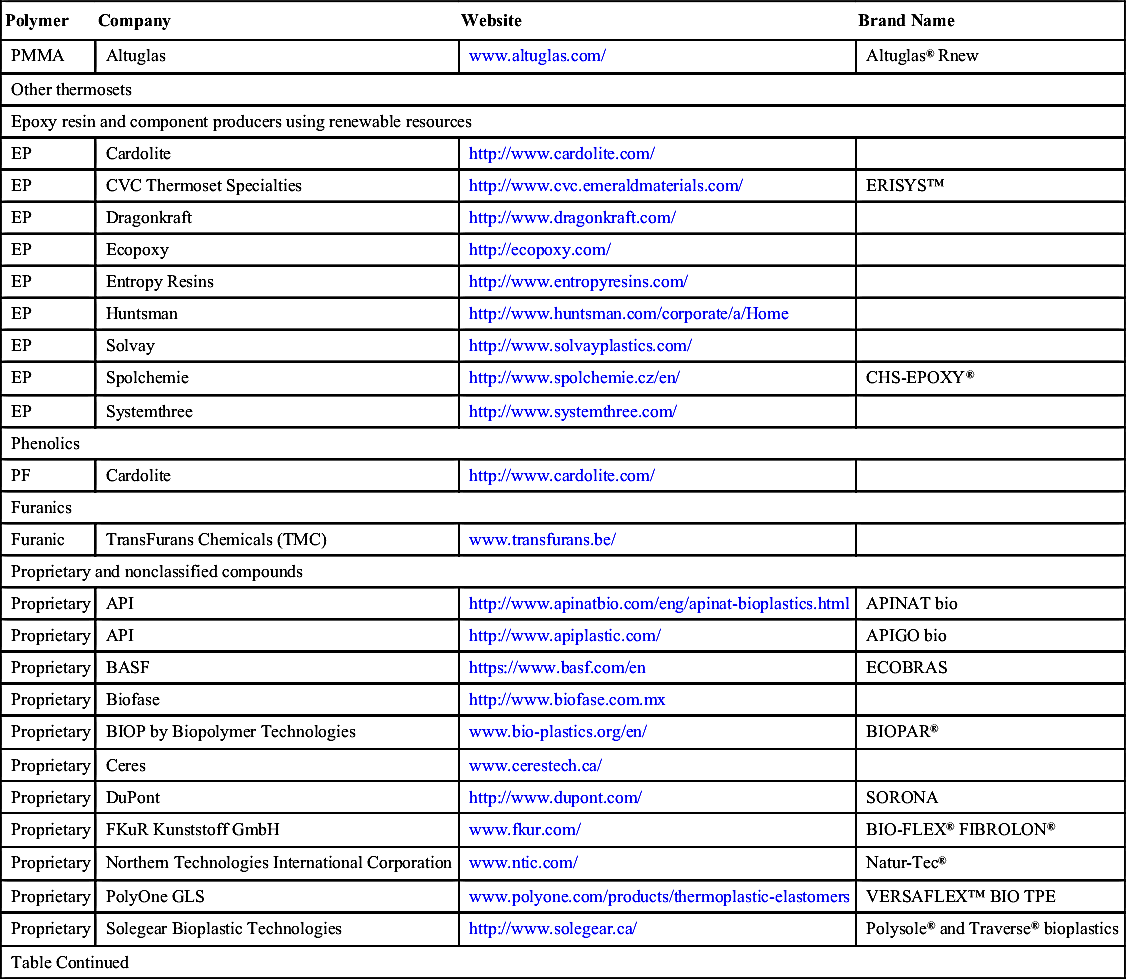
| Polymer | Company | Website | Brand Name |
| Algae/PO | Algix | www.algix.com | Solaplast |
| Algae/PBAT | Algix | www.algix.com | Solaplast |
| Algae/PP | Algix | www.algix.com | Solaplast |
| Algae/EVA | Algix | www.algix.com | Solaplast |
| Algae/PS | Algix | www.algix.com | Solaplast |
| PBS, starch, and PLA | Showa Denko | http://www.showa-denko.com/news/starcla-bio-based-bionolle-resin/ | Bionolle Starcla™ |
| Starch/PP | Green Dot Holdings | http://www.greendotpure.com/ | Terratek® |
| Starch PS | Resirene | http://resirene.com/ | Biorene |
| Starch PE | Cardia Bioplastics | http://www.cardiabioplastics.com/ | Cardia Biohybrid™ |
| Starch PP | Cardia Bioplastics | http://www.cardiabioplastics.com/ | Cardia Biohybrid™ |
| Copolyester/fossil TP | PolyOne | www.polyone.com/ | reSound™ |
| PLA/ABS | JSR | http://www.jsr.co.jp/jsr_e/ | BIOLLOY™ |
| Composites | |||
| Natural fibers and renewable matrices | |||
| PLA NF | FKuR | www.fkur.com/ | FIBROLON® |
| Bio-PE NF | FKuR | www.fkur.com/ | Terralene® |
| Proprietary | Futuramat | http://www.futuramat.com/ | |
| Bio-TP NF | Tecnaro | http://www.tecnaro.de/english/ | ARBOFORM ARBOBLEND |
| Bio-composite | Fasal | http://www.fasal.at | fasal® bio |
| Bio-composite | Composites evolution | http://www.compositesevolution.com/ | |
| Hybrid composites: fossil plastic reinforced with renewable fiber | |||
| PP NF | Composites Evolution | http://www.compositesevolution.com/ | Biotex |
| PP NF | FKuR | www.fkur.com/ | FIBROLON® |
| Proprietary | Tecnaro | http://www.tecnaro.de/english/ | ARBOFILL |
| PP NF | GreenGran | http://www.greengran.com/ | |
| PP cellulose fiber | RTP Company | http://www.rtpcompany.com/ | |
| Proprietary, ABS NF, PP NF | Futuramat | http://www.futuramat.com/ | PolyFibra® |
| Hybrid composites: renewable plastic reinforced with fossil fiber | |||
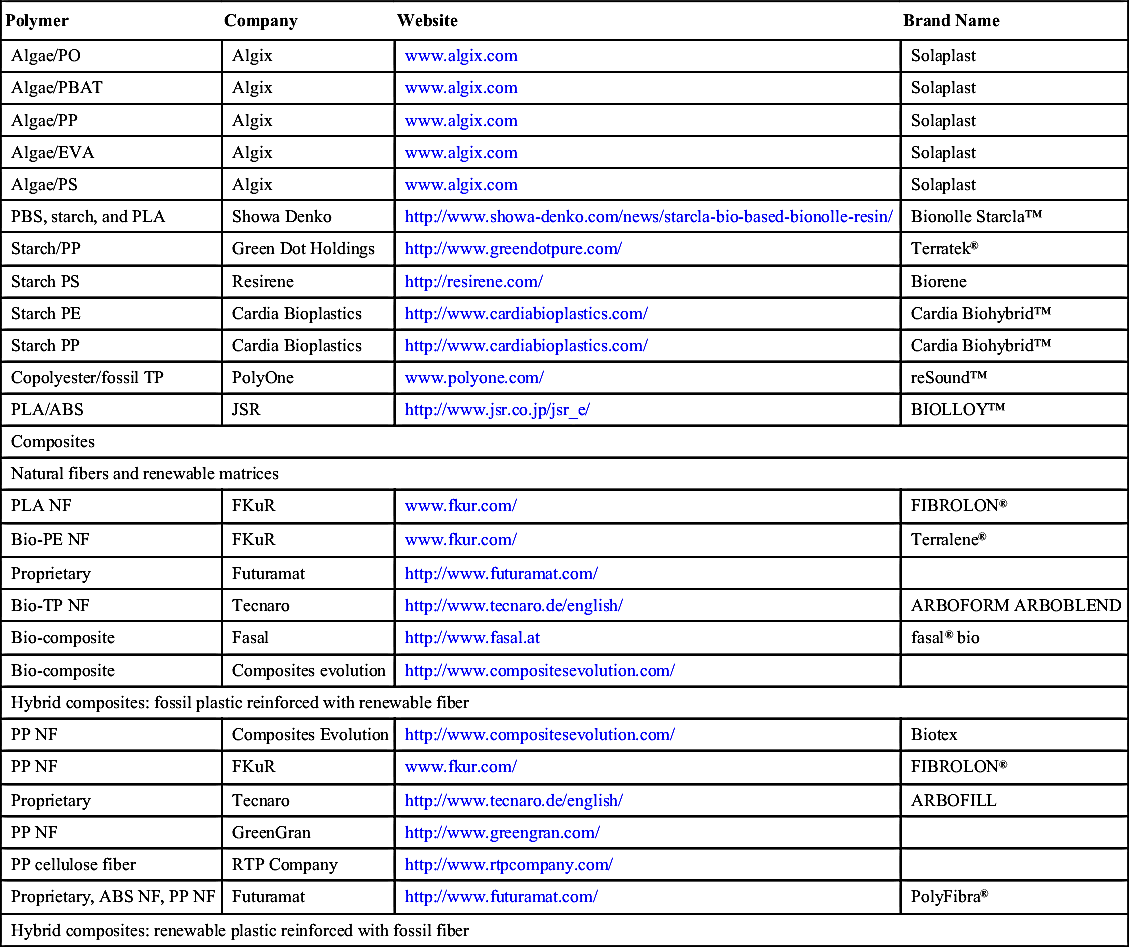
Table 2.4
Recyclers and Producers of Additives for Recyclate Upgrading
| Ampacet | http://www.ampacet.com/ | |
| Arkema | http://www.arkema.com/en | |
| BASF | https://www.basf.com/en | |
| BIR | http://www.bir.org/industry/plastics/ | |
| British plastics Federation—BPF | http://www.bpf.co.uk/ | |
| Brueggemann | http://www.brueggemann.com/english/ | |
| Carbios | http://www.carbios.fr/ | |
| Carbon Fiber Remanufacturing (CFR) | http://carbonfiberremanufacturing.com/ | |
| Chase Plastics | http://chaseplastics.com/ | |
| Chemtura | http://www.chemtura.com/ | |
| Dexco Polymers | http://tsrcdexco.com/en | |
| Dow | http://www.dow.com/ | |
| DuPont | http://www.dupont.com/ | |
| EPA (US Environmental Protection Agency) | www.epa.gov/ | |
| European Food Safety Agency (EFSA) | http://www.efsa.europa.eu/fr/ | |
| Joint Venture SGL Automotive Carbon Fibers | https://www.sglgroup.com/cms/international/products/ | Recafil CF Recatex CF |
| Kraton Polymers | http://www.kraton.com/ | |
| MA Polymers | http://ma-polymers.de/ | |
| Momentive | http://www.momentive.com/ | |
| RAMPF | http://www.rampf-gruppe.de/en/ | |
| Recoup | www.recoup.org/ | |
| Sabic | https://www.sabic-ip.com/ | |
| Samsung | http://www.samsungchemical.com | |
| Wietek | http://www.wietek.com/wietek.htm |
Table 2.5
Examples of Additives for Renewable Plastics
| Arkema | http://www.arkema.com/en | Biostrength |
| BASF | https://www.basf.com/en | Joncryl ADR |
| Cardolite | http://www.cardolite.com/ | CNSL |
| CelluForce | www.celluforce.com/fr/ | Nanocellulose cristalline (NCC TM) |
| Clariant | http://www.clariant.com/en/Corporate | CESA Renol |
| Croda | http://www.croda.com/ | Solasorb IncroMax Atmer |
| Table Continued | ||
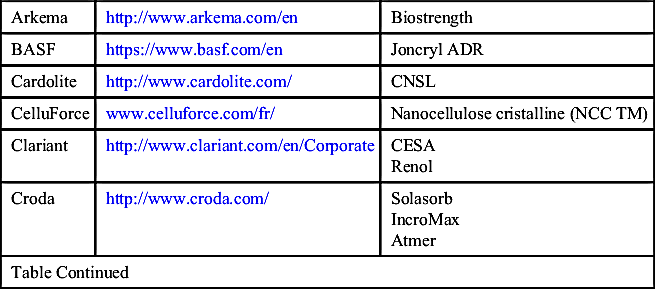
| Dow (Rohm and Haas) | http://www.dow.com/ | PARALOID™ |
| DuPont | http://www.dupont.com/ | Biomax |
| Gabriel-Chemie | http://www.gabriel-chemie.com/en/ | MAXITHEN® BIOL |
| Goulston | http://www.goulston.com/ | |
| Hallstar | https://www.hallstar.com/ | HallGreen |
| Holland colours HCA | http://hollandcolours.com/ | |
| KHS | http://freshsafepet.khs.com/en.php#3-technology | KHS Plasmax |
| Lapol | http://www.lapol.net/ | |
| Meco Energie-Kollektoren | http://www.mecostat.com/en/ | |
| Patco additives | http://www.chemnet.com/Suppliers/9717/ | With Pationic |
| PolyOne Corporation | http://www.polyone.com/ | ColorMatrix |
| Polyvel | http://www.polyvel.com/ | |
| Robinson Brothers | http://www.robinsonbrothers.co.uk/pages/products | |
| Sidel | http://www.sidel.com/ | Actis |
| Sukano | http://www.sukano.com/eu/ | |
| Takemoto Oil & Fat Co | http://www.takemoto.co.jp/en/ | |
| Teknor Color Company | http://www.teknorapex.com/ | |
| Viba Group | http://www.vibagroup.com/ | Vibatan |
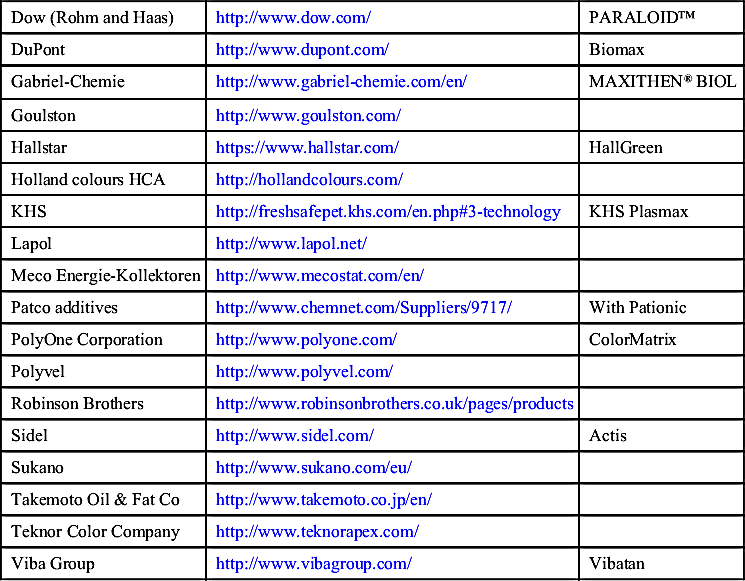
Table 2.6
Bio-monomers and Bio-bricks for Drop-in Solutions
| Amyris | https://amyris.com/ | |
| Anellotech | http://anellotech.com/ | |
| Archer Daniels Midland Company—ADM | http://www.adm.com/en-US/products/industrial/Pages/default.aspx | |
| Arkema | http://www.arkema.com/en | Bio-acrylic acid Plexiglas® Rnew |
| Avantium | http://www.avantium.com/ | YXY green building blocks |
| BASF | https://www.basf.com/en/company/news-and-media/news-releases/2015/03/p-15-163.html | Bio-based PolyTHF |
| BASF | http://www.polyurethanes.basf.com/pu/ | PHB/starch/and polypropylene carbonate (PPC) |
| Bayer MaterialScience | http://www.press.bayer.com/baynews/baynews.nsf/id/ | Polyether carbonate polyols |
| Bio-Amber | http://www.bio-amber.com/bioamber/en/products | Bio-based Succinic acid, butanediol (BDO) and Tetrahydrofuran (THF) |
| Cardia Bioplastics | http://www.cardiabioplastics.com/media/media-item?newsId=57 | Poly (propylene carbonate) (PPC) |
| Table Continued | ||


| LanzaTech technology | http://www.lanzatech.com/ | Acetic acid |
| Lubrizol (Merquinsa). | http://www.merquinsa.com/ | Biotpu |
| M&G (Gruppo Mossi and Ghisolfi) | http://www.gruppomg.com/en/business/bio-polyester-feedstock | Biopolyester |
| Metabolic Explorer—METEX | http://www.metabolic-explorer.com/contenu.php?rub=biotech&ssrub=6 | Propanediol |
| Metabolix Inc. | http://www.metabolix.com/ | |
| Mitsubishi Chemical | http://www.m-kagaku.co.jp/english/products/business/polymer/sustainable/details/1194667_3255.html | DURABIO™ |
| Mitsubishi Rayon | https://www.mrc.co.jp/english/ | Bio-MMA |
| Mitsui chemicals | http://www.mitsuichem.com/release/2014/141211.htm | Pentamethylene diisocyanate(PDI®) |
| Myriant | http://www.myriant.com/applications/polyester-polyols.cfm | Poly(butylene succinate) (PBS) |
| Neste Oil | https://www.neste.com/ | |
| Novomer | http://www.novomer.com/ | CONVERGE® polyols |
| Novomer | http://www.novomer.com/ | Polypropylene carbonate (PPC) |
| Novomer | http://www.novomer.com/ | Propiolactone |
| Novozymes | http://www.novozymes.com/en/ | C4 dicarboxylic acids, malic acid, fumaric acid and succinic acid GBL (γ-butyrolactone) |
| Novozymes and Cargill | Hydroxypropionic (3-HP) and acrylic acid | |
| Novozymes and Dacheng Group, | Plant-based glycols | |
| Oleon | http://www.oleon.com/ | |
| Repsol | http://www.repsol.com/es_en/ | Polyolpolycarbonate |
| Reverdia | http://www.reverdia.com/ | Biosuccinium™ |
| Roquette | http://www.roquette.com/ | POLYSORB® isosorbide |
| Solvay Indupa (Buenos Aires | http://www.solvayindupa.com/en/index.html | |
| Succinity (BASF and Corbion Purac) | http://www.succinity.com/ | Succinity® biobased succinic acid |
| Toyota Tsusho | http://www.globio.jp/en/concept1.html | Globio (BioPET) |
| Virent | http://www.virent.com/ | Bioterephthalic acid |
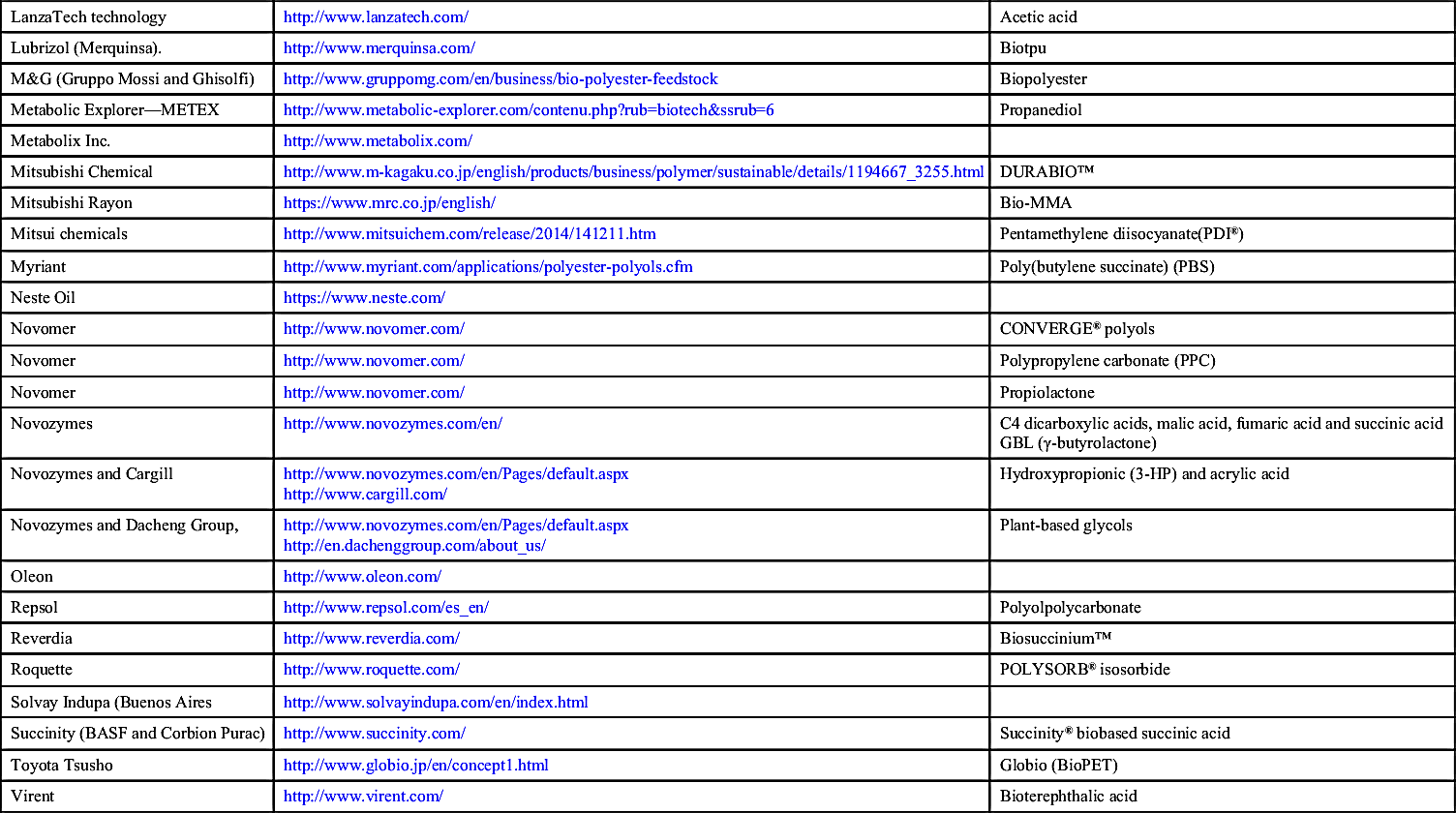
Table 2.7
Examples of Renewable Additives
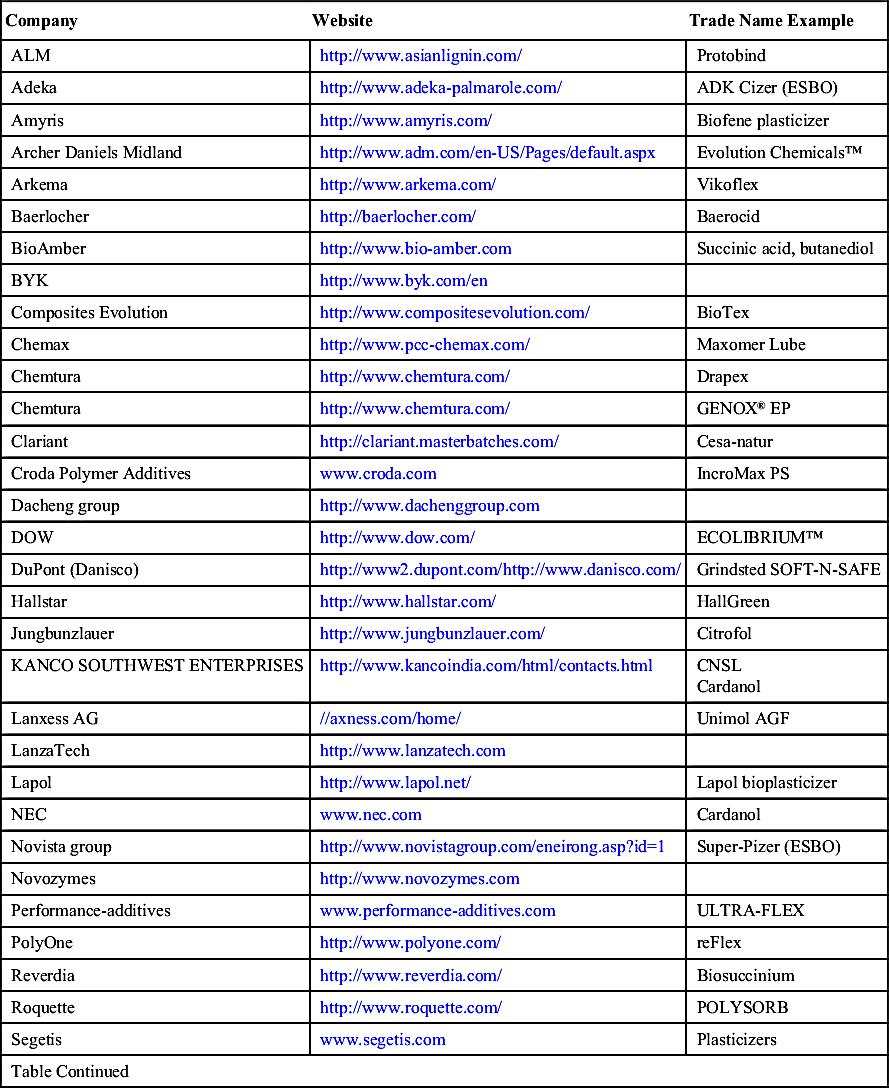
| Company | Website | Trade Name Example |
| Teijin Ltd. | www.teijin.co.jp/english/ | Biofront |
| Proquitec | http://www.proquitec.com.br/ | PLASTITEC FF |
| SGS Polimeros | http://www.sgspolimeros.com.br/ | Olvex 50 plasticizer |
| Teknor Apex | http://www.teknorapex.com/division/bioplastics | TerraloyTM |
| VARTECO QUIMICA PUNTANA | http://www.varteco.com.ar/en/products | |
| VTT | http://www.vtt.fi/ | LGF process |

Table 2.8
Examples of Renewable Plasticizers and Producers
| Epoxidized oils | |||
| Arkema | http://www.arkema.com/en/products/ | Vikoflex | Epoxidized vegetable oil |
| Baerlocher | http://www.baerlocher.com/ | Baerostab H2000 IN | Epoxidized soybean oil |
| Chang Chun Petrochemical | http://www.ccp.com.tw/ | Epoxidized soybean oil (ESBO) | Epoxidized soybean oil (ESBO) |
| Hebei Jingu Plasticizer | http://www.hbjingu.com/plasticizer/ | HY–B, HY, S, Z | Epoxy fatty acid methyl ester, Epoxidized soybean oil |
| Michael Ballance plastics | http://www.ballance-plastics.co.uk/ | MONSOL ESBO | Epoxidized soybean oil |
| Nanjing Capatue chemica | http://www.capatue.com/english/ | Epoxidized soybean oil | Epoxidized soybean oil |
| New Japan chemical | http://www.nj-chem.co.jp/en/ | SANSO CIZER | Epoxidized linseed oil |
| Novista | http://www.novistagroup.com/eindex.asp | Epoxidized soybean oil | Epoxidized soybean oil |
| Petrom | http://plsgreen.com.br/en/ | PLS green | ESBO based (amyl, octyl, or nonyl epoxy stearate) |
| The chemical company | https://www.thechemco.com/chemical/ | Epoxidized soybean oil (ESO) | Epoxidized soybean oil (ESO) |
| Varteco Quimica Puntana | http://www.varteco.com.ar/en/home | Kalflex Varflex | Epoxidized soybean oil and primary plasticizers mixture |
| Zhejiang Jiaao Enprotech Stock | http://www.jiaaohuanbao.com/en/ | Epoxidized soybean oil (ESO) | Epoxidized soybean oil |
| Table Continued | |||

| Esters | |||
| Aekyung Petrochemical | http://www.akp.co.kr/eng/ | NEO-C | Mixed alcohol ester |
| Arkema Casda Biomaterials | http://casda-biomaterials.lookchem.com/ | Dibutyl sébacate (DBS) | Dibutyl sébacate (DBS) |
| Casda Biomaterials | http://casda-biomaterials.lookchem.com/ | Dimethyl sebacate (DMS | Dimethyl sebacate |
| Casda Biomaterials | http://casda-biomaterials.lookchem.com/ | Dioctyl sebacate(DOS) | Dioctyl sebacate(DOS) |
| Hallstar | http://www.hallstar.com/ | Hallgreen® | Plant-derived ester |
| Hallstar | http://www.hallstar.com/ | Plasthall PR, ELO, ESO | Renewable ester |
| Jayant Agro-Organics | http://www.jayantagro.com/ | Dicapryl sebacate (DCS) | Castor oil Dicapryl sebacate |
| Jungbunzlauer | http://www.jungbunzlauer.com/ | Citrofol | Acetyl tributyl citrate, Tributyl citrate, Acetyl triethyl citrate, acetyl citrate |
| Oxea | http://www.oxea-chemicals.com/ | OXBLUE® ATBC | Acetyl tributyl citrate |
| Oxea | http://www.oxea-chemicals.com/ | OXBLUE® DOSX | Dioctyl succinate [bis (2-ethylhexyl) succinate] |
| PVC renewable plasticizer | PolyOne | www.polyone.com/ | Geon™ BIO Flexible Solutions |
| Rhein Chemie Additives (Lanxess) | http://www.rheinchemie.com/http://lanxess.com/en/ | Unimoll AGF | Mixture of glycerine acetates |
| Rhein Chemie Lanxess | http://lanxess.com/en/rhein-chemie/ | Rhenosin® | Fatty acid esters |
| Vertellus Specialties | http://www.vertellus.com/ | Citroflex® | Citrate esters |
| Vegetable oil derivatives | |||
| Arizona Chemical | http://www.arizonachemical.com/products/ | Sylfat™ | Tall oil fatty acid |
| Chlorinated plasticizer extracted from vegetable oil | |||
| Danisco (DuPont Group) | http://plasticadditives.dupont.com/products/soft_n_safetm/ | GRINDSTED®SOFT-N-SAFE™ | Castor oil derivative |
| Darwin Chemical Company | http://www.darwinchemical.com/ | Castor oil | Triglyceride of fatty acid |
| Meadwestvaco | http://www.mwv.com/en-us/ | MWV Rosin | Tall oil rosin |
| Oleon Sofiproteol | http://www.oleon.com/ | Radia | Rapeseed oil-based |
| Seatons | http://www.seatons-uk.co.uk/ | Blown castor oil | Oxidatively polymerized castor oil |
| Table Continued | |||
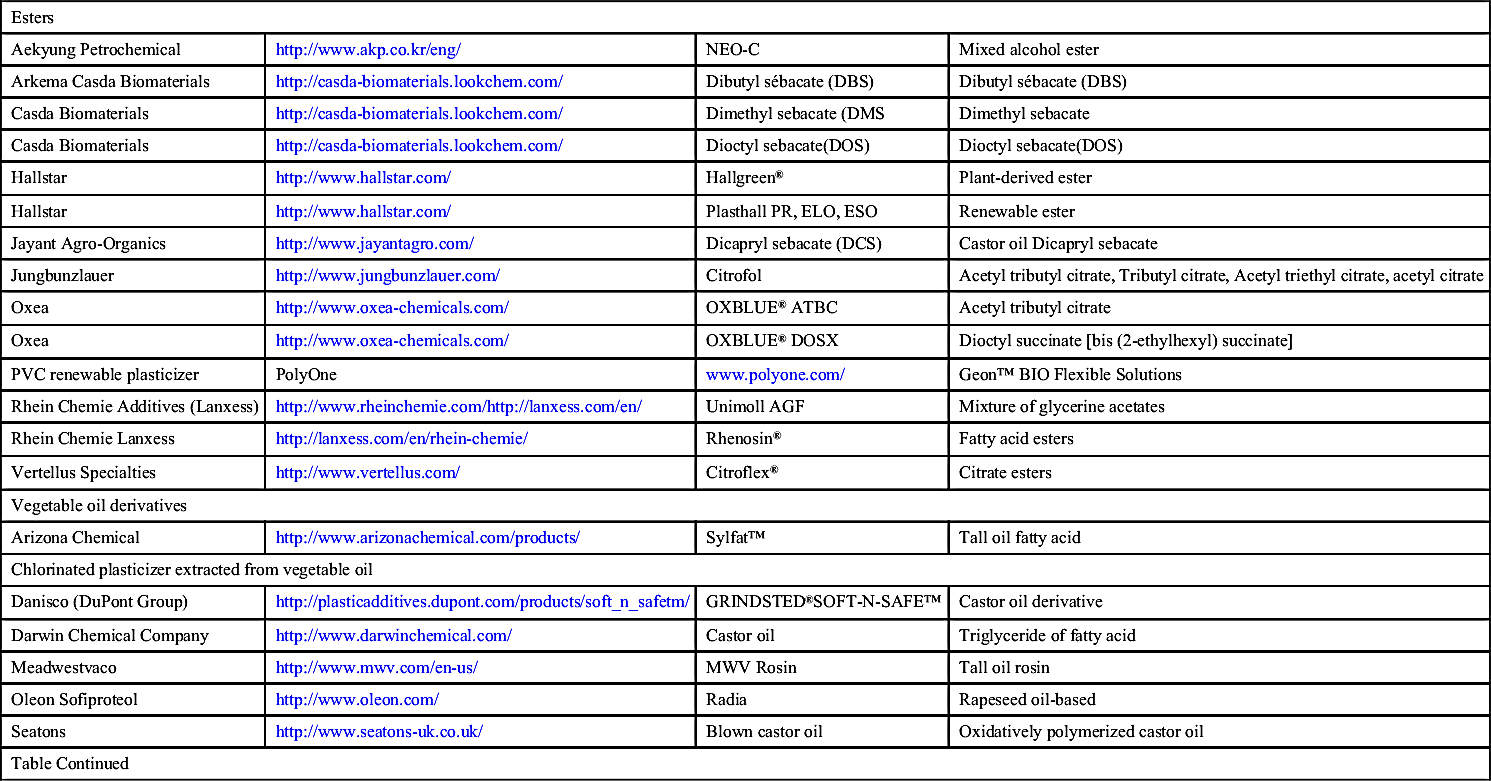
| Tall oil derivatives | |||
| Zhejiang Jiaao Enprotech Stock | http://www.jiaaohuanbao.com/en/ | JLD | Extracted from vegetable oil by modification |
| Zhejiang Jiaao Enprotech Stock | http://www.jiaaohuanbao.com/en/ | JLD 819 | Chlorinated plasticizer extracted from vegetable oil |
| Miscellaneous plasticizers | |||
| Dow Chemical | http://www.dow.com/ | Dow Ecolibrium™ | Bio-based plasticizer |
| Emery Oleochemicals | http://www.emeryoleo.com/ | EDENOL® LOXIOL® | Trimellitate, sebacate, azelaic, adipate esters; polymeric plasticizer based on adipic acid |
| Galata Chemicals | http://www.galatachemicals.com/ | Drapex Alpha | |
| Lapol | http://www.lapol.net/ | Lapol | |
| Nexoleum | http://nexoleum.com/english/products.html | Nexo | Methyl epoxy soyate |
| PolyOne | http://www.polyone.com/en-us/ | ReFlex | |
| Proviron | http://www.proviron.com/ | Proviplast | |
| Resypar Industria e Comercio | http://www.resypar.com.br/eng/ | Resyflex | |
| Roquette | www.roquette.com | Polysorb | Isosorbid derivative |

Table 2.9
| Emery Oleochemicals | http://www.emeryoleo.com/ | EDENOL® LOXIOL® | Rheology modifier |
| Fine organics | http://www.fineorganics.com/ | Finaid | Processing aid |
| Fine organics | http://www.fineorganics.com/ | FINALUX, Finastat | Processing aid |
| Hallstar | http://www.hallstar.com/ | Hallgreen R | Processing aid (plant-derived ester) |
| JJI Technologies | http://www.jji-technologies.com/ | Jemini 100™ | Process aid |
| Lapol | http://www.lapol.net/ | Lapol | Rheology modifier |
| New Japan Chemical | http://www.nj-chem.co.jp/en/ | GEL ALL | Rheology modifier |
| Pcc-chemax | http://www.pcc-chemax.com/ | Maxomer Lube | Vegetable-based processing aids |
| Performance additives | http://www.performance-additives.com/ | Ultra-Plast™ | Processing aid (fatty acid derivatives) |
| Soy Technologies | http://www.soytek.com/ | Soyanol™ | Coalescing agent (soy-based alkyl resin) |
| Table Continued | |||
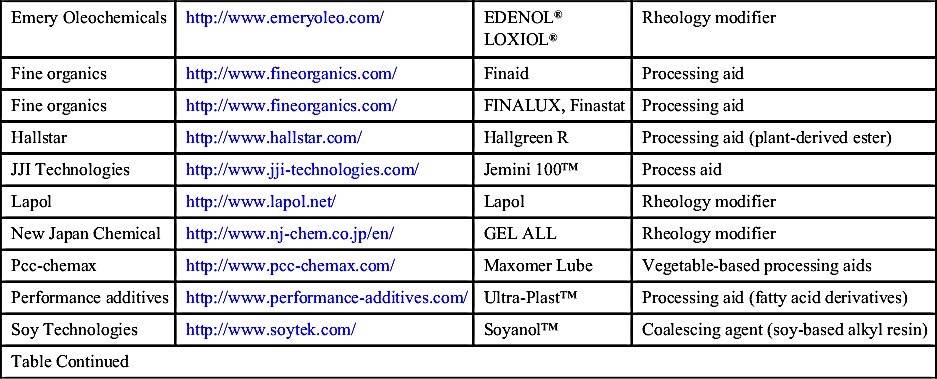
| Struktol | http://www.struktol.com/ | Struktol | Polymeric processing aid (fatty acid derivatives) |
| Struktol | http://www.struktol.com/ | Struktol® WS 280 PASTE | Processing aid (blend of fatty acid derivatives and silicone) |
| Vertellus Specialties | http://www.vertellus.com/ | Castorwax® | Processing aid (glycerol tri-(12-hydroxystearate) |
| VÖLPKER® | http://voelpker.com/en/ | Waradur® | Process aid (derived from lignite∗) |

Table 2.10
Examples of Surface Friction Modifiers
| AddComp | http://www.addcomp.nl/ | ADD-VANCE SA | Slip agent (masterbatch formulated with oleamide) |
| Blachford | http://www.blachford.ca/ | Aluminum stearate | antitack agent |
| Croda | http://www.crodapolymeradditives.com/ | IncroMax | Slip agents |
| Croda | http://www.crodapolymeradditives.com/ | Crodamide | Antiblocking agents |
| Croda | http://www.crodapolymeradditives.com/ | Ethylene bis stearamide | Antiblocking agents |
| Croda | http://www.crodapolymeradditives.com/ | Erucamide derivatives | Antiblocking agents |
| Croda | http://www.crodapolymeradditives.com/ | Stearates | Antiblocking agents |
| Croda SIPO | http://www.sipo.com.cn/ch/ | Oleamide | Slip agent |
| Darwin Chemical Company | http://www.darwinchemical.com/ | Erucamide | Antisticking (nitrogen derivatives of erucic acid) |
| Domus Chemicals | http://www.domuschemicals.it/ | DOMPLAST BIO | Fatty acid ester. Lubricant |
| Emery Oleochemicals | http://www.emeryoleo.com/ | EDENOL® LOXIOL® | Antiblocking agents |
| Emery Oleochemicals | http://www.emeryoleo.com/ | EDENOL® LOXIOL® | Lubricant |
| Fine Organics | http://www.fineorganics.com/ | FINALUX, Finastat | Lubricant |
| Frank B Ross | http://www.frankbross.com/ | Hydrogenated castor oil | Lubricant (hydrogenated castor oil) |
| Honeywell | http://www.honeywell-additives.com/ | Rheolub® RL | Lubricant (blend of in-situ calcium stearate and fatty acid esters) |
| HUZHOU SHENGTAO BIOTECH | http://www.shengtao.com/products/main_en.html | Rice bran wax | Lubricant |
| Table Continued | |||
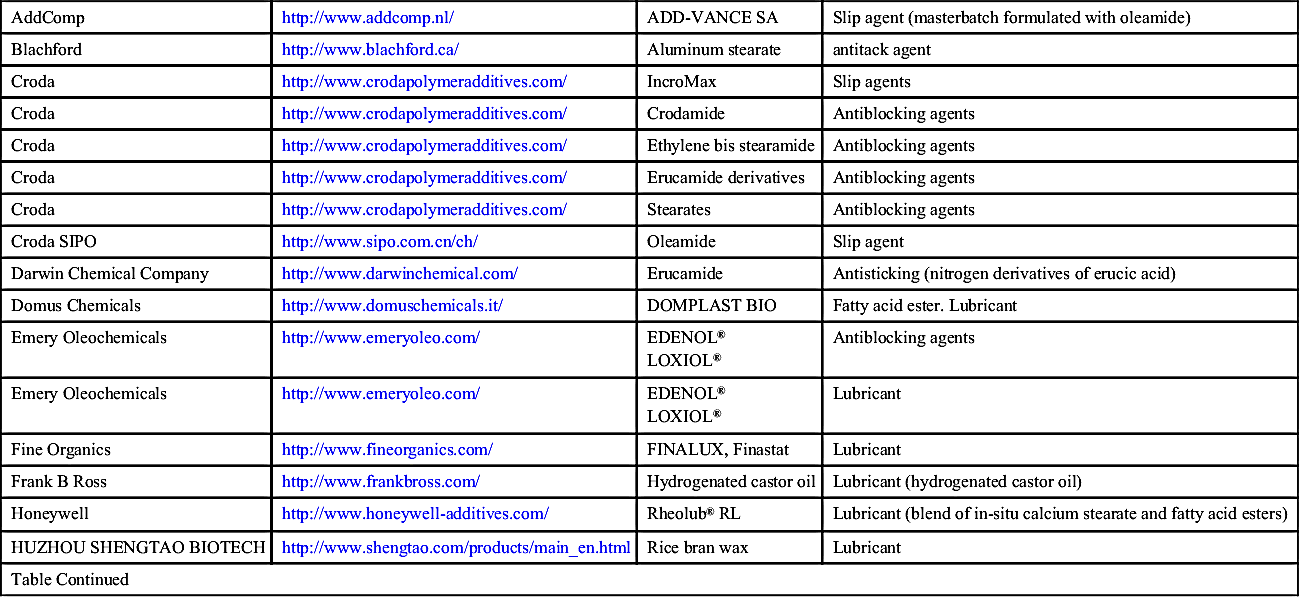
| Kerax | http://www.kerax.co.uk/ | Keratech | Lubricant (hydrogenated castor oil–Hydroxy stearic acid) |
| NAYAKEM ORGANICS | http://www.nayakem.com/ | Butylstearate | Lubricant |
| New Japan Chemical | http://www.nj-chem.co.jp/en/ | RIKAFLOW EP | Lubricant |
| Performance-Additives | http://www.performance-additives.com/ | ULTRA-PLAST™ | Slip agents |
| Peter Greven FettChemie | http://www.peter-greven.de/en/ | Ligalub | Lubricant |
| Peter Greven FettChemie | http://www.peter-greven.de/en/ | Ligastab | Lubricant (metal salt of stearic acid) |
| Pilipinas Kao | http://chemical.kao.com/ | KALCOL | Lubricant fatty alcohol |
| Riken | http://www.rikenvitamin.com/chemicals/plastics.html | Rikemal Rikemaster | Antiblocking agents |
| SO.G.I.S. Industria Chimica | www.sogis.com/ | CALCIUM STEARATE Zinc stearate Stearine Waxso | Lubricant |
| Struktol | http://www.struktol.com/ | Struktol | Lubricant, (fatty acid derivatives) |
| VÖLPKER® | http://voelpker.com/en/ | Waradur® | Lubricant (derived from lignite) |

Table 2.11
| Danisco (DuPont Group) | http://plasticadditives.dupont.com/products/ | Dimodan HP | Release agent |
| Darwin Chemical Company | http://www.darwinchemical.com/ | Erucamide | Release agent (nitrogen derivatives of erucic acid) |
| Domus Chemicals | http://www.domuschemicals.it/ | DOMPLAST BIO | Fatty acid ester. Release agent |
| Emery Oleochemicals | http://www.emeryoleo.com/ | EDENOL® LOXIOL® | Release agent |
| Fine Organics | http://www.fineorganics.com/ | Finalux | Release agent |
| Riken | http://www.rikenvitamin.com/chemicals/plastics.html | Rikemal Rikemaster | Release agents |
| SO.G.I.S. Industria Chimica | www.sogis.com/ | Calcium stearate Zinc stearate Stearine Waxso | Release agent |

Table 2.12
| A Schulman | http://www.aschulman.com/Default.aspx?reset=2 | Polywhite® | Masterbatch containing antistatic additive, titanium dioxide in polyethylene |
| Croda | http://www.crodapolymeradditives.com/ | Atmer | Anti-static |
| Croda SIPO | http://www.sipo.com.cn/ch/ | Behenamide | Antistatic agent |
| Danisco (DuPont Group) | http://plasticadditives.dupont.com/products/ | Dimodan HP | Antistatic agent |
| Danisco (DuPont Group) | http://www.dupont.com/products-and-services/food-ingredients/brands/danisco-food-ingredients.html | GRINDSTED® AR,PGE, PS | Antistatic agents |
| Darwin Chemical Company | http://www.darwinchemical.com/ | Erucamide | Antistatic agent (nitrogen derivatives of erucic acid) |
| Emery Oleochemicals | http://www.emeryoleo.com/ | EDENOL® LOXIOL® | Antistatic agent |
| Fine Organics | http://www.fineorganics.com/ | Finalux | Antistatic agent |
| MLPlastics Additive Masterbatches | PE STA1905, SLA, LTA | Antistatic agents of vegetable origin in PE carrier resin | |
| PolyOne | http://www.polyone.com/ | OnColor BIO | |
| Riken | http://www.rikenvitamin.com/chemicals/plastics.html | Rikemal Rikemaster | Antistatic agents |

Table 2.13
Examples of Optical Property Modifiers
| Clariant | http://www.clariant.fr/ | RENOL®-natur color masterbatches | Color |
| Croda | http://www.crodapolymeradditives.com/ | Atmer | Antifogging agents |
| Emery Oleochemicals | http://www.emeryoleo.com/ | EDENOL® LOXIOL® | Antifogging agents |
| Fine Organics | http://www.fineorganics.com/ | Finafog | Antifogging agents |
| Riken | http://www.rikenvitamin.com/chemicals/plastics.html | Rikemal Rikemaster | Antifogging agents |
| SO.G.I.S. Industria Chimica | www.sogis.com/ | CALCIUM STEARATE Zinc stearate Stearine Waxso | Antifogging agents |
| Tianyi Chemical Engineering Material | http://en.tianyi-chemical.com/ | APL 308 | Gloss imparting, grinding agent (zinc stearate) |

Table 2.14
| Addivant | www.addivant.com/ | GENOX® EP | Heat Stabilizer |
| Akcros Chemicals | http://www.akcros.com/ | Akcrostab® LT | Heat and light stabilizer (mixed metal epoxidized soybean oil blend) |
| Baerlocher | www.baerlocher.com/ | Baerostab® LSA, LSU, NT | Heat and light stability (epoxized soybean oil) |
| Cardolite | https://www.cardolite.com/automotive | Cashew nut shell liquid (CNSL) | Heat stabilizer |
| Clariant | https://www.clariant.com/masterbatches | CESA-natur antioxidants | Antioxidant (vitamin E) |
| Clariant | https://www.clariant.com/masterbatches | CESA-natur light masterbatches | Light stabilizer |
| Nanjing Capatue chemica | http://www.capatue.com/english/ | Caplig | Hindered amine light stabilizer (HALS) (Bis-tetramethyl-sebacate) |
| Peter Greven FettChemie | http://www.peter-greven.de/en/ | LIGA calcium behenate | Heat stabilizer (calcium salt of behenic acid) |
| Catechin and epicatechin | Heat stabilizer (green tea extract) |

Table 2.15
Examples of Miscellaneous Renewable Additives
Sylvatac® RE SYLVAPACK™ RE Sylvalite RE | Tackifier (pentaerythritol ester of rosin) (stabilized tall oil rosin ester and crude sulphate turpentine) (polyol ester of rosin) | Arizona Chemical | http://www.arizonachemical.com/ |
Oleris® 2-Octanol Fatty alcohol based | Solvent and antifoaming agent | Arkema | http://www.arkema.com/ |
| Polycard XFN™ | Flame retardant (renewable aromatic multifunctional polyol—cashew shell oil-based) | Composite Technical Services | http://ctsusa.us/ |
| Novocard | Biobased epoxy hardeners systems | Composite Technical Services | http://ctsusa.us/ |
| Walnut Shell Fillers | Filler | Composition Materials Co | http://compomat.com/ |
| NatureWax | Wax | Elevance Renewable Sciences | http://www.elevance.com/ |
| Montan Wax | Wax (derived from lignite) | Frank B Ross | http://www.frankbross.com/ |
| Kronitex CDP, TCP | Flame retardant (naturally derived cresyl diphenyl phosphate; naturally derived cresol-based tricresyl phosphate) | Great Lakes Chemtura | http://www.greatlakes.com/ |
| Table Continued | |||

| Rice bran wax | Wax | HUZHOU SHENGTAO BIOTECH | http://www.shengtao.com/products/main_en.html |
| BioRes | Laurel BioComposite | https://www.laurelbiocomposite.com/ | |
| MWV Rosin | Tackifier (tall oil rosin) | Meadwestvaco | http://www.mwv.com/en-us/ |
| GEL ALL | Nucleating agent | New Japan Chemical | http://www.nj-chem.co.jp/en/ |
| NeroPlast® | Filler | New Polymer Systems | http://www.newpolymersystems.com/ |
| BioTred | Filler (starch) | Novamont | www.novamont.com |
| Sacrificial binder | Sacrificial binder (polypropylene carbonate—PPC) | Novomer | http://www.novomer.com/ |
| Charmor™ PM40 Care | Flame retardant (pentaerythritol derivative) | Perstorp | https://www.perstorp.com/ |
| Piccolyte® | Tackifier (polyterpene resin) | Pinova | http://www.pinovasolutions.com/ |
Staybelite® Pexalyn® | Tackifier (rosin derivative) | Pinova | http://www.pinovasolutions.com/ |
| GLIDOX™ | Polymerization initiator (terpene hydroperoxide) | Renessenz | http://www.renessenz.com/site/ |
| Terpene resin | Tackifier (terpene resin) | Rosin Chemical Wuping | http://www.rosin-wuping.com/en-index.html |
| Waradur® | Wax (derived from lignite) | VÖLPKER® | http://voelpker.com/en/ |
| BioSphere | Plastic additives | www.biosphereplastic.com | |
| Cashew nut shell liquid (CNSL) | Curing agent for epoxies |
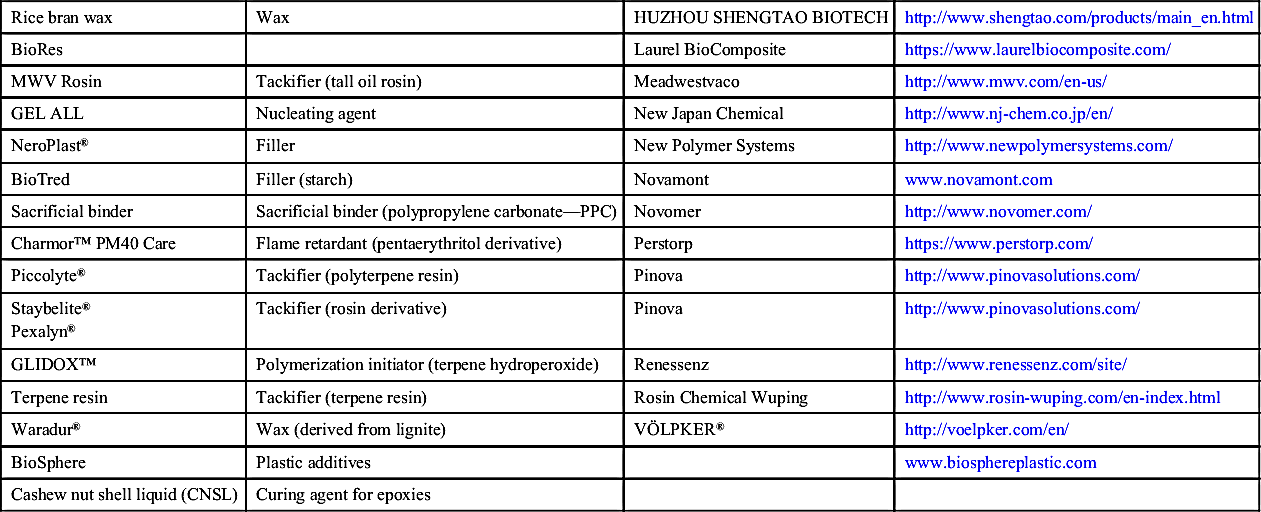
Table 2.16
Examples of Masterbatches Based on Renewable Polymers
| Bylox compound | Bioadditive masterbatch | Genarex | http://www.genarex.com/ |
| CM, CN, CP | Bioadditives masterbatches based on PLA | Polyvel | http://www.polyvel.com/ |
PHA Cellulose Starch PLA Bio-PE, PA11, PA6, PA10, | Renewable carrier: PHA Cellulose Starch PLA Bio-PE PA11 PA6 PA10 | ||
| PLA/PHA masterbatch | Renewable carrier: PLA | Metabolix | http://www.metabolix.com/ |
| Terraloy 9000 | Renewable carrier: PLA | Teknor Apex | |
| VIBATAN | Renewable carrier: PLA | Viba Group | http://www.vibagroup.com/en/ |
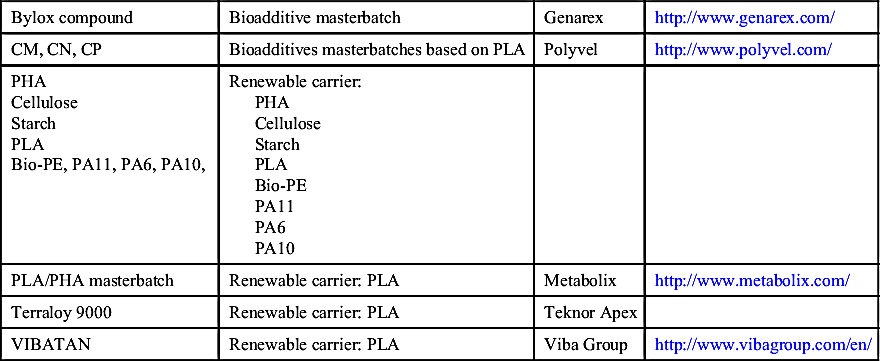
Table 2.17
Examples of Market Study Specialists, Associations, and Institutes Dealing With Renewable Materials

